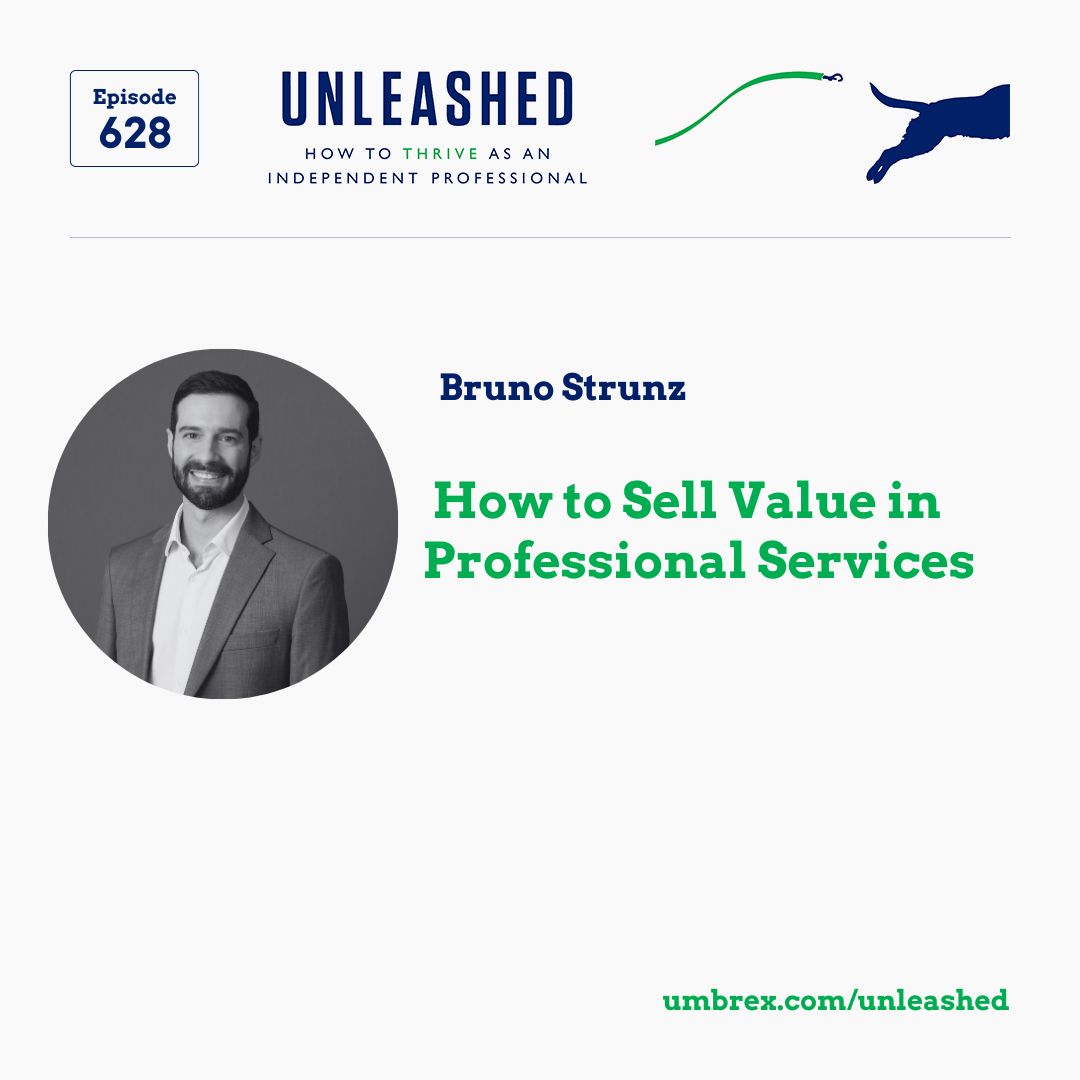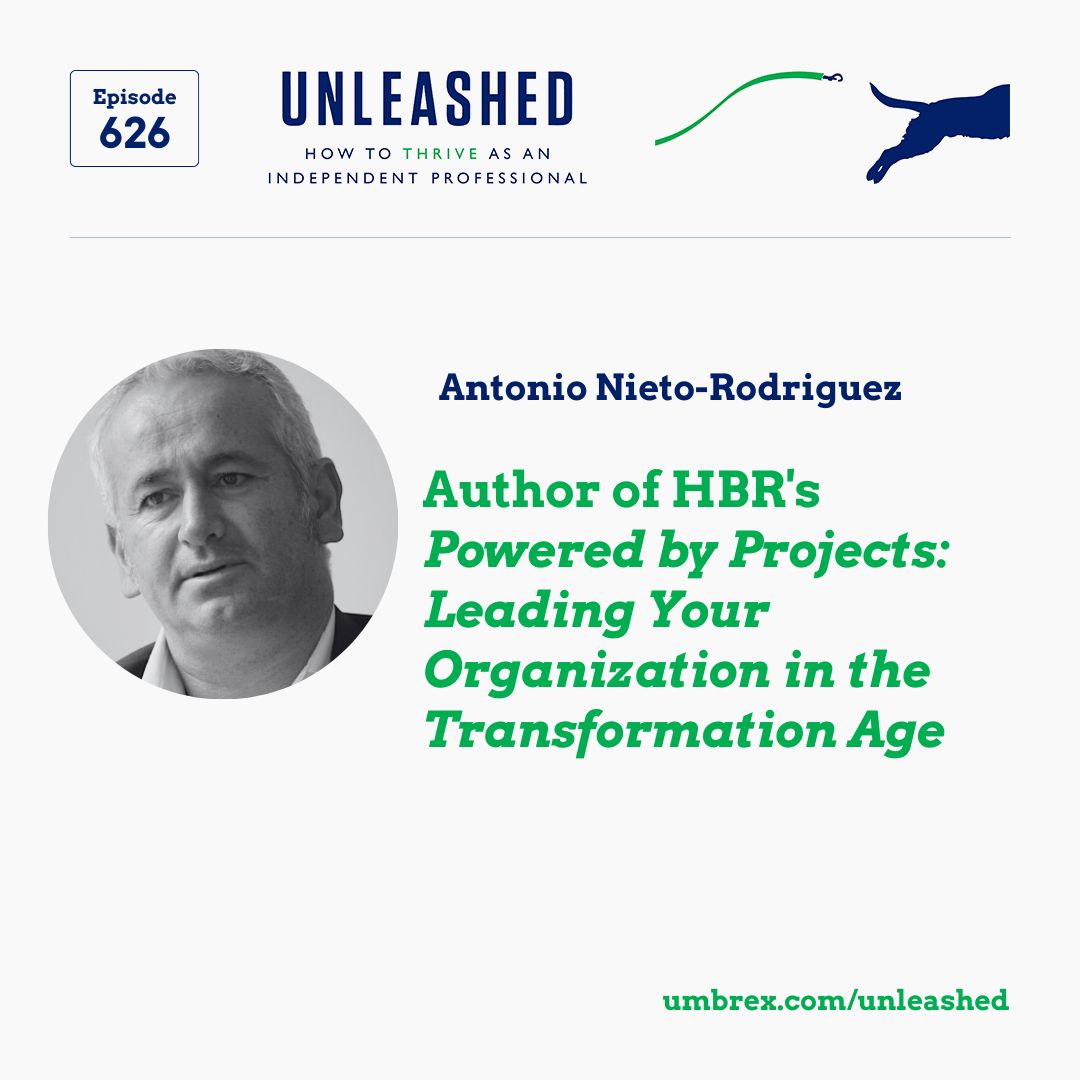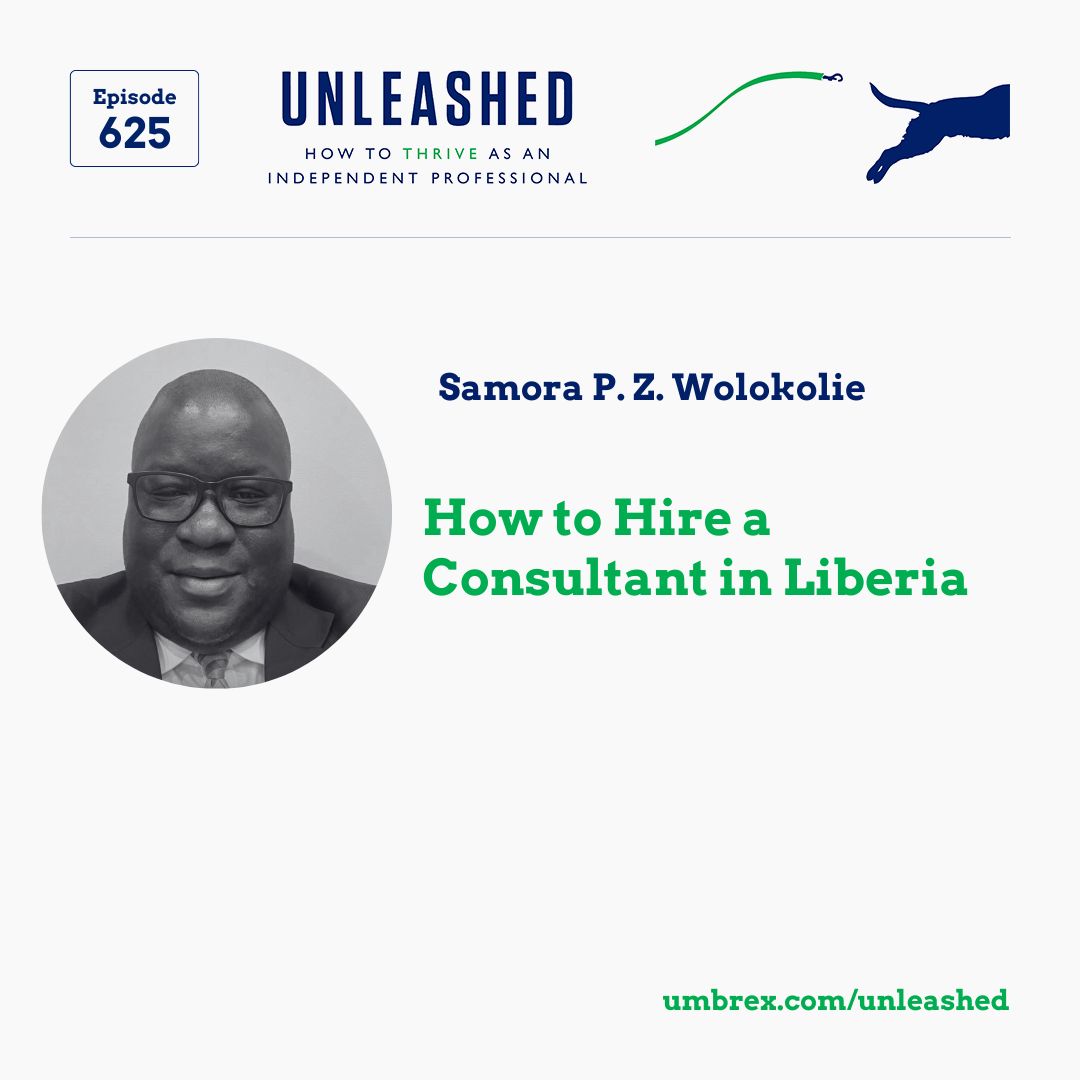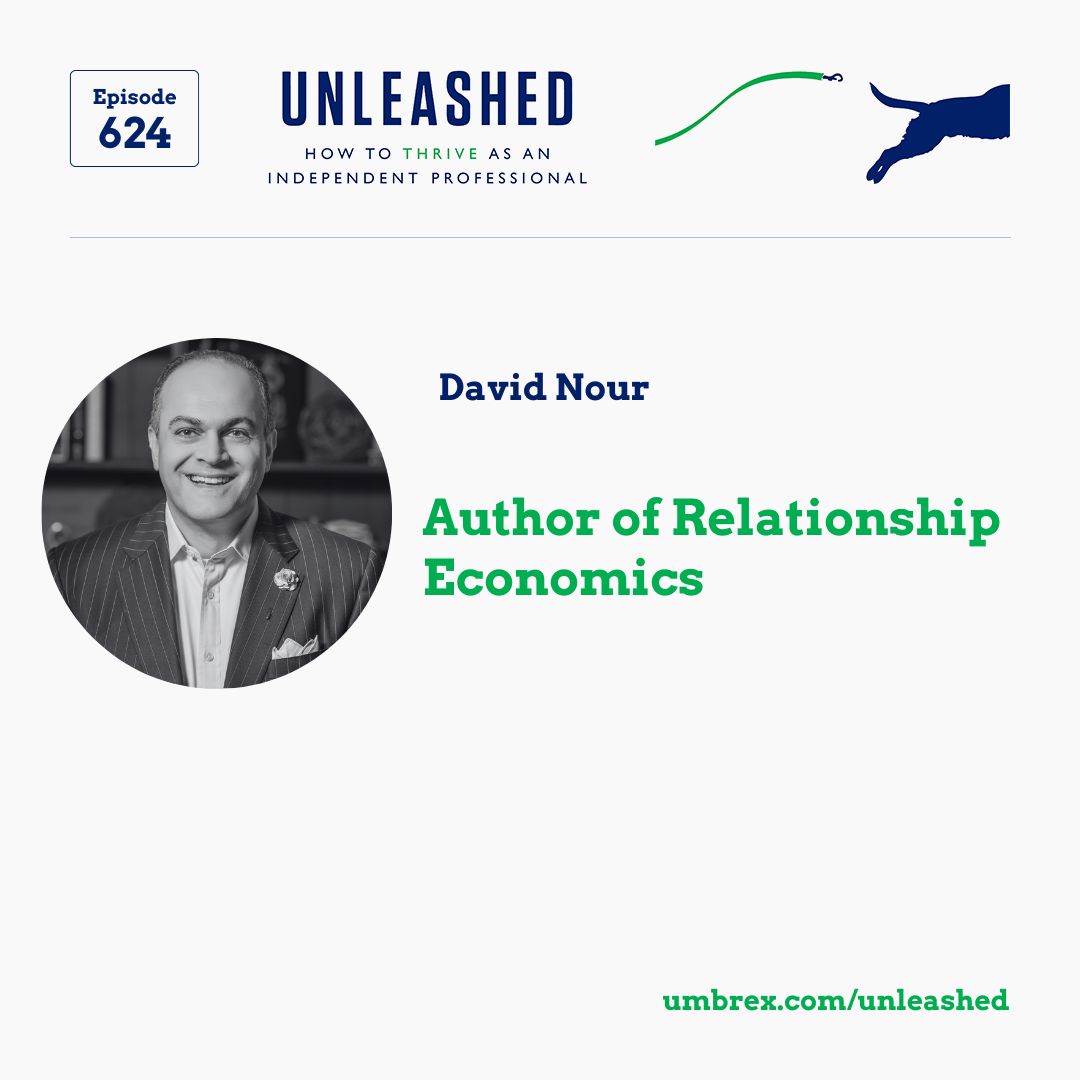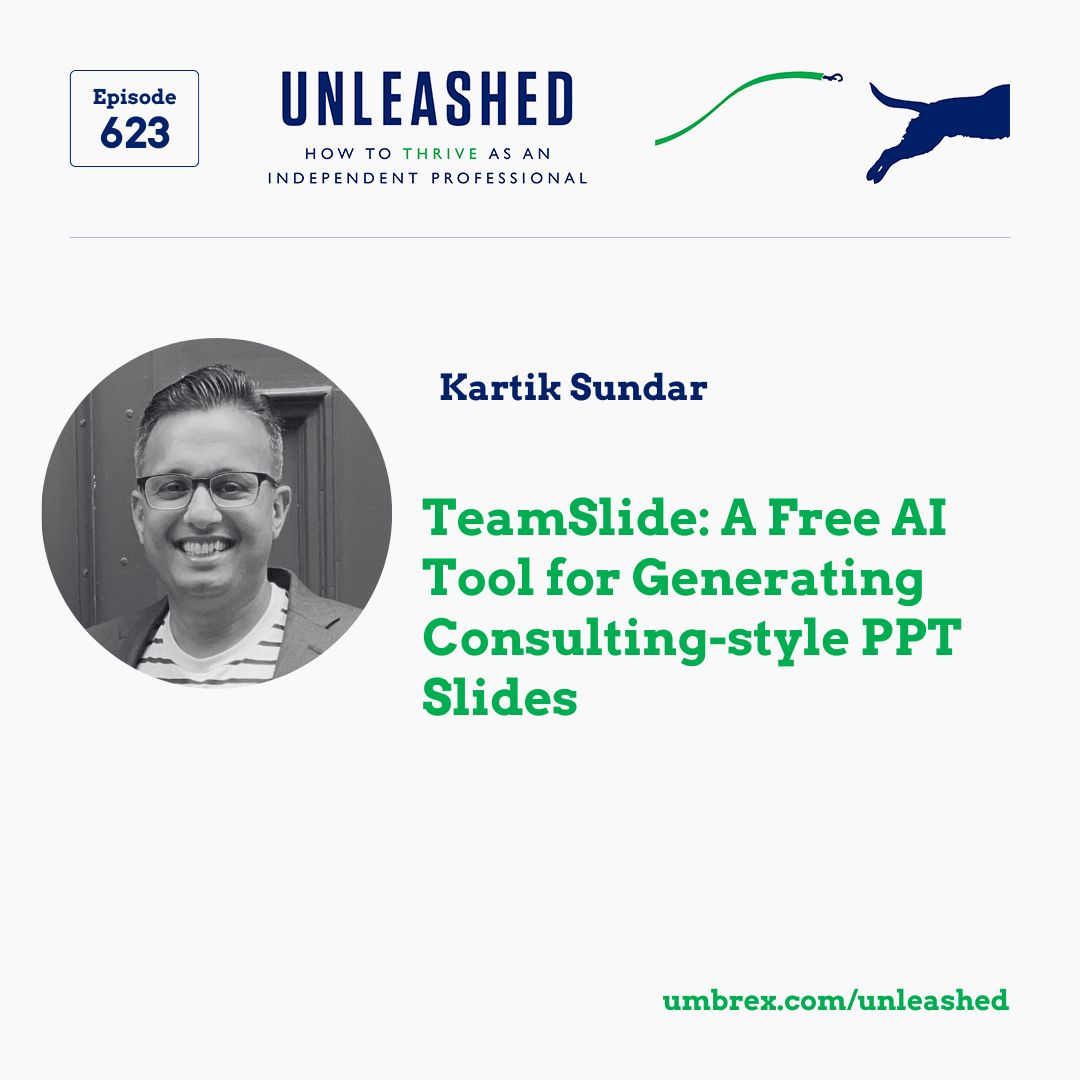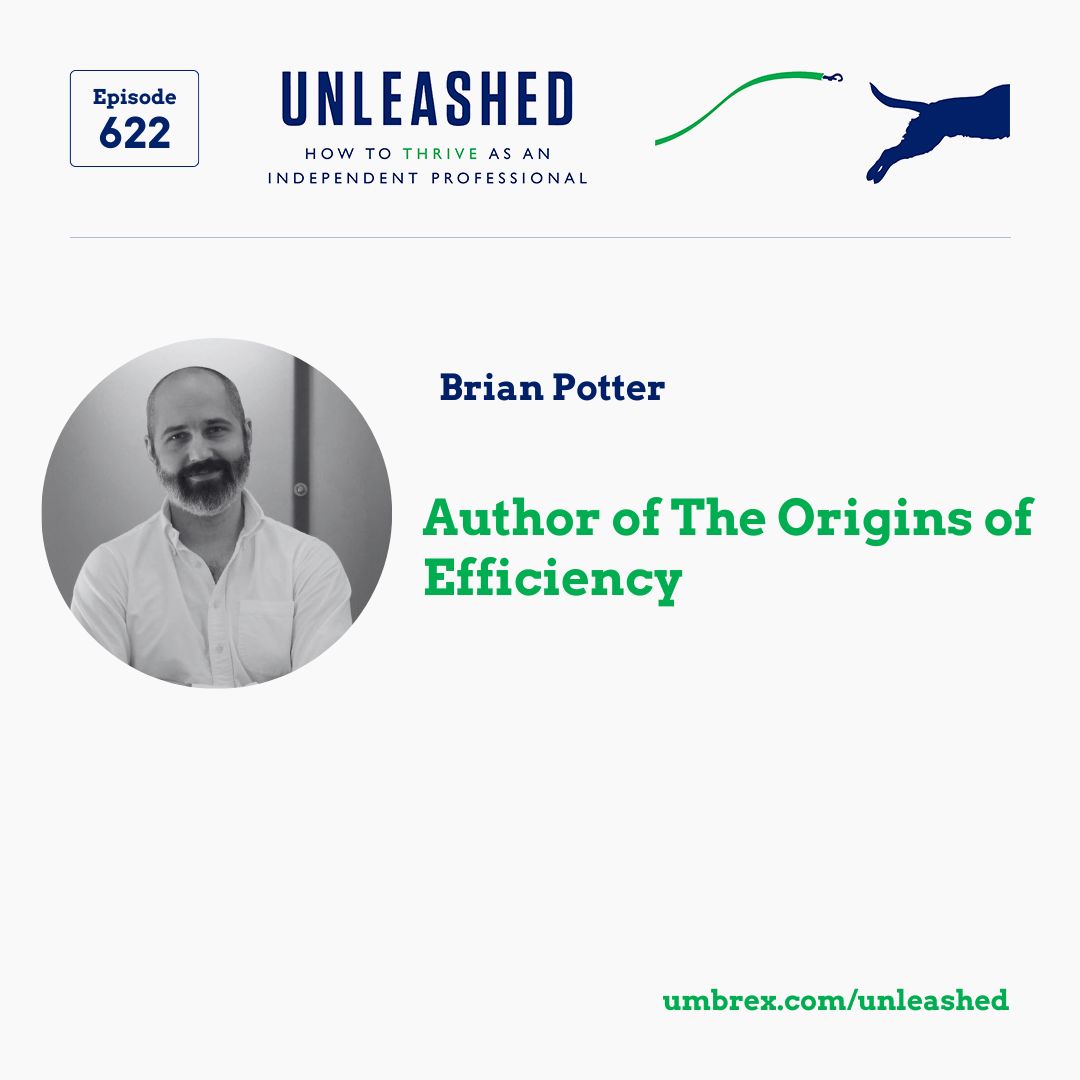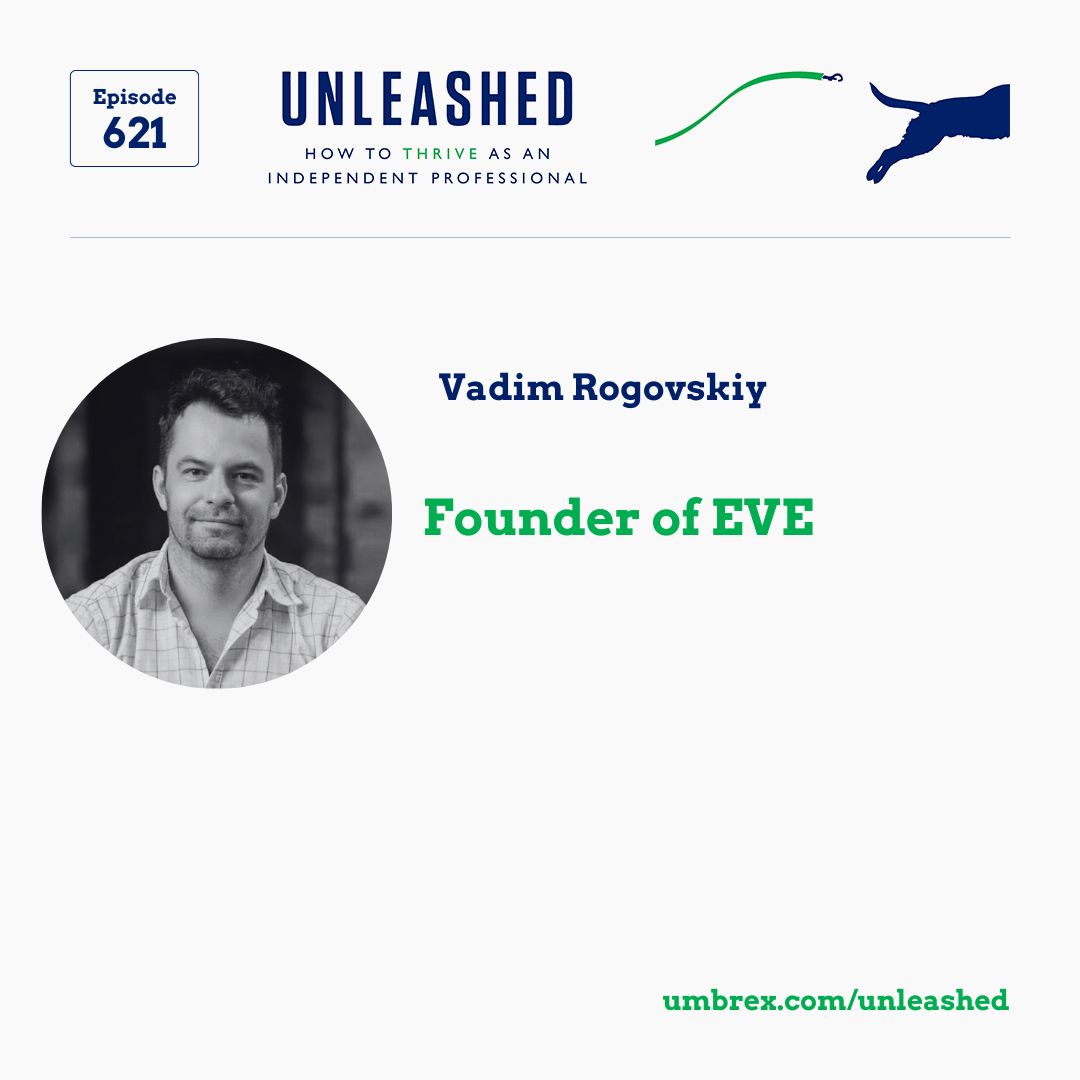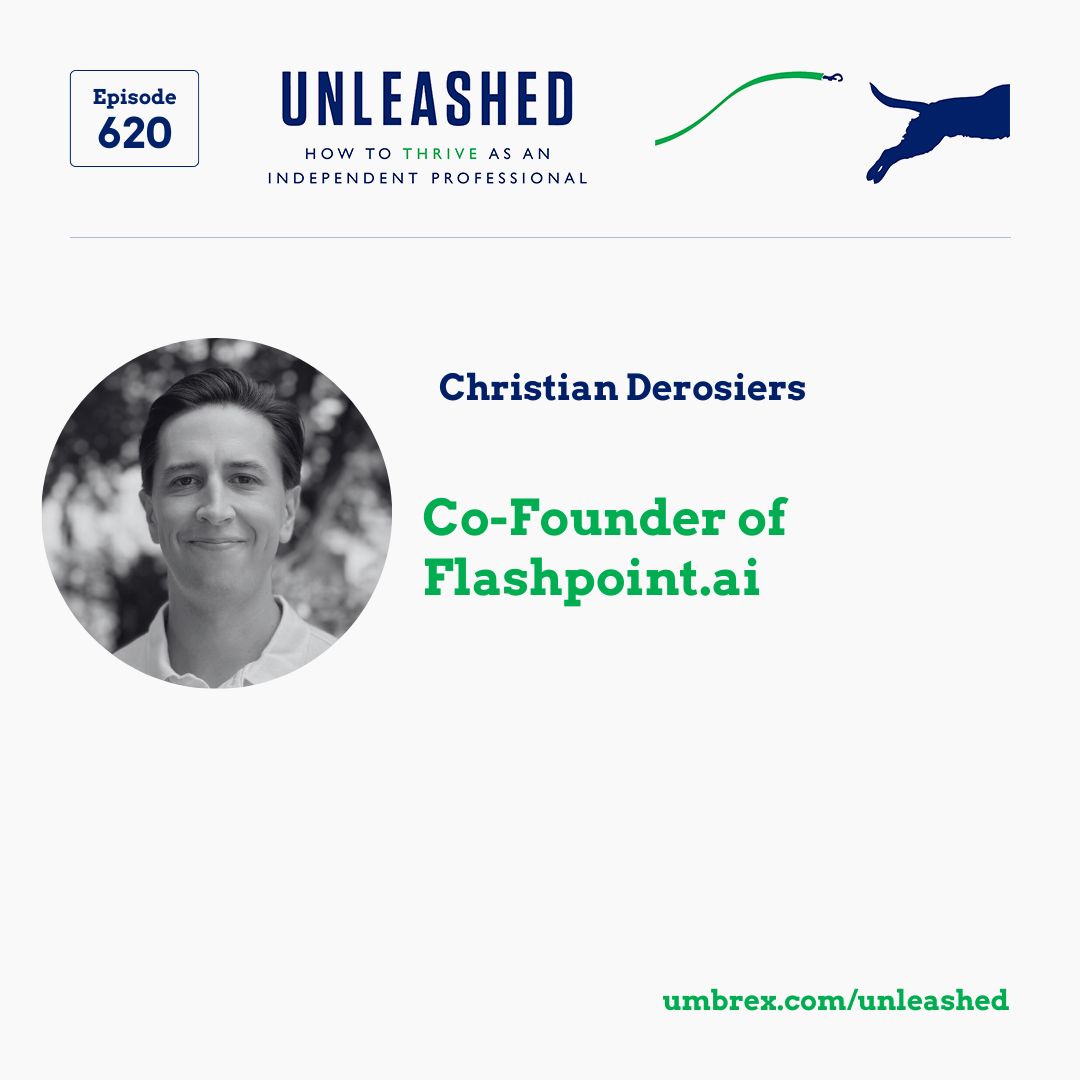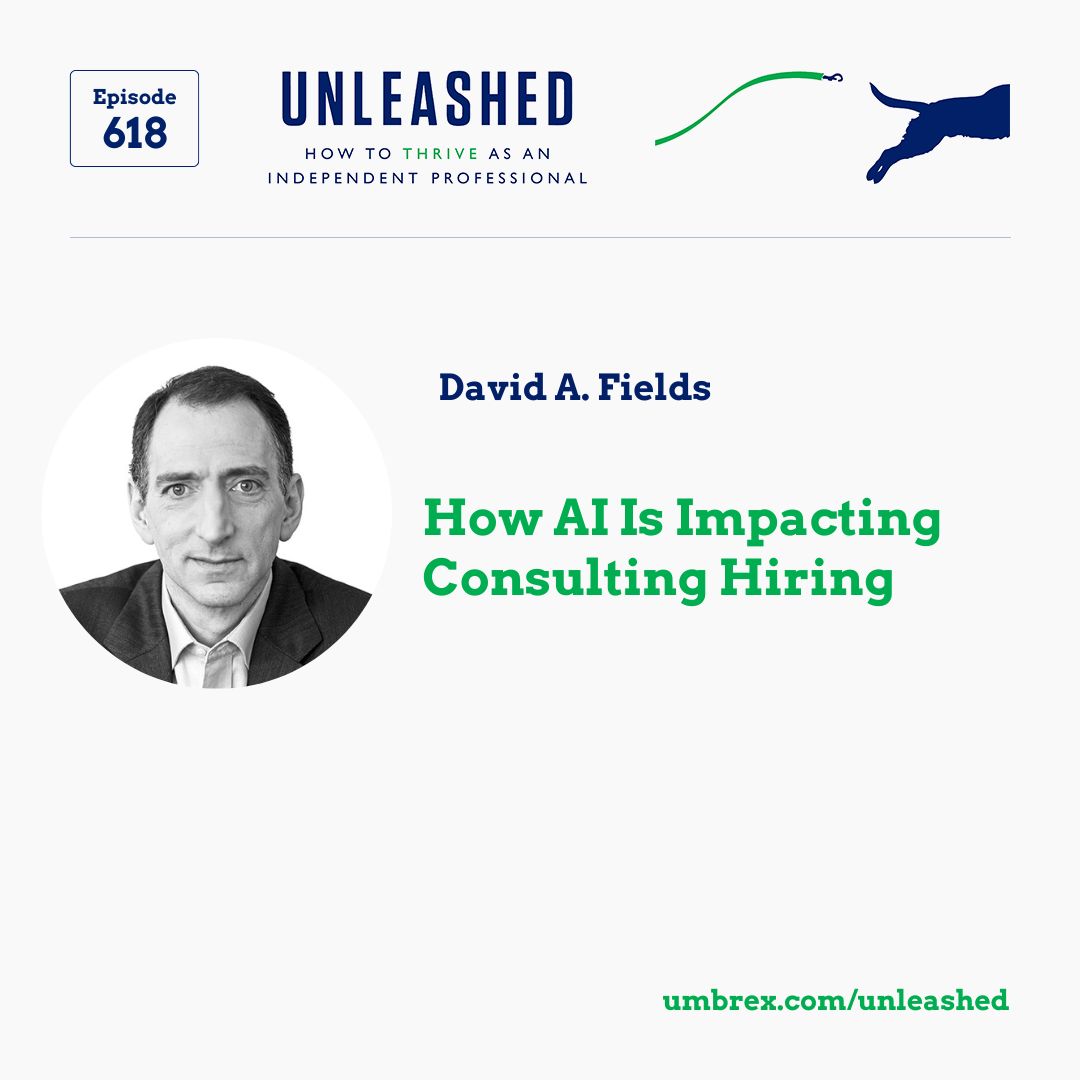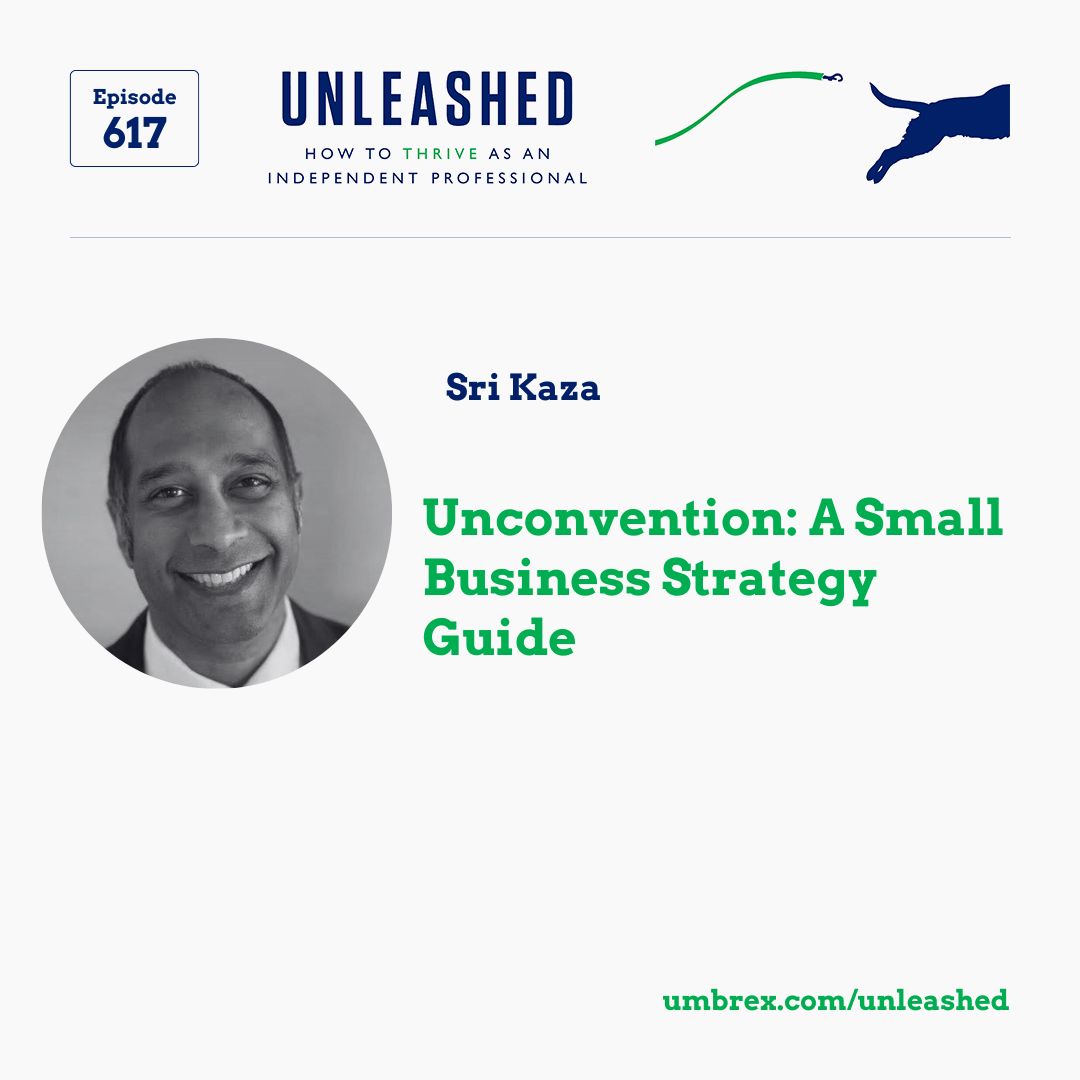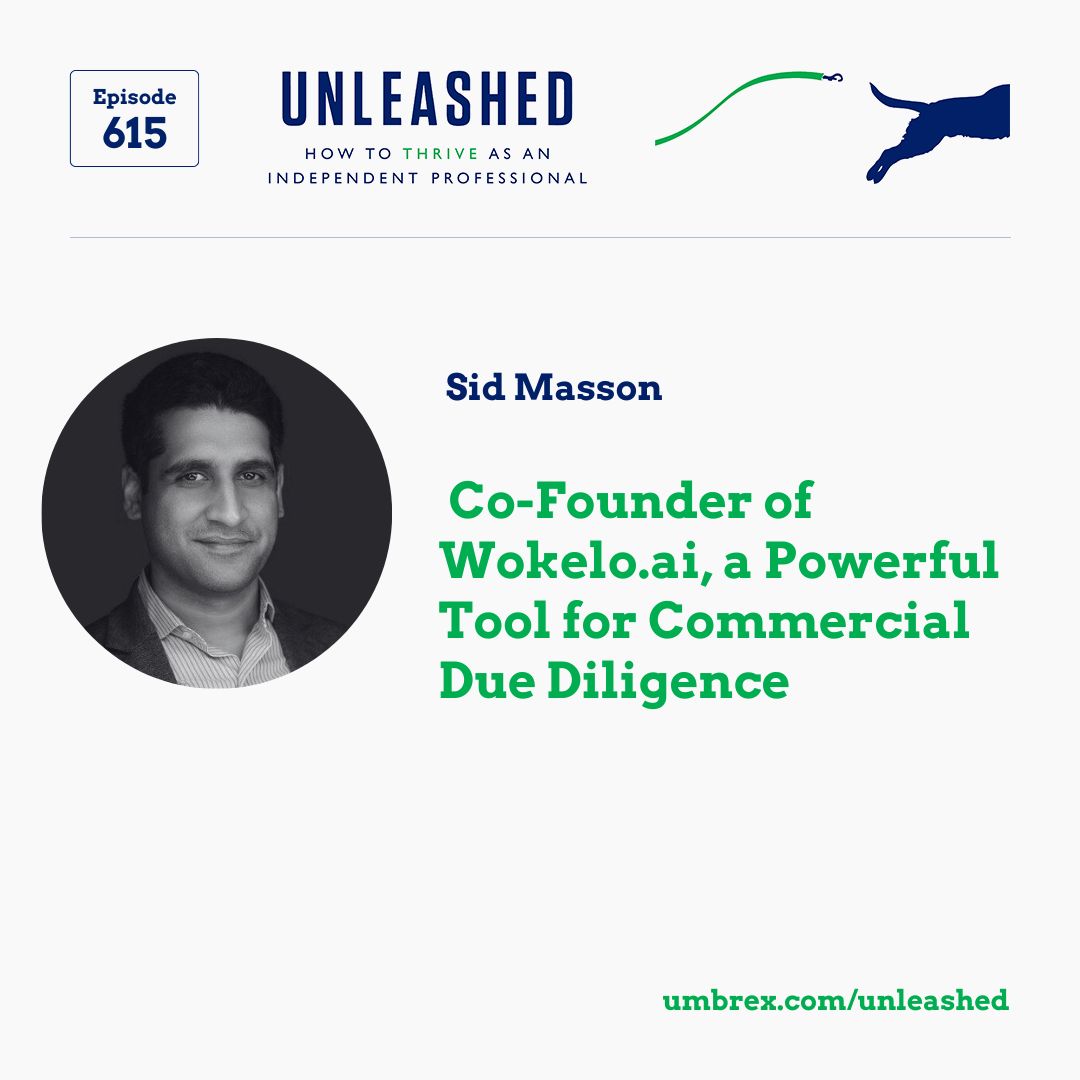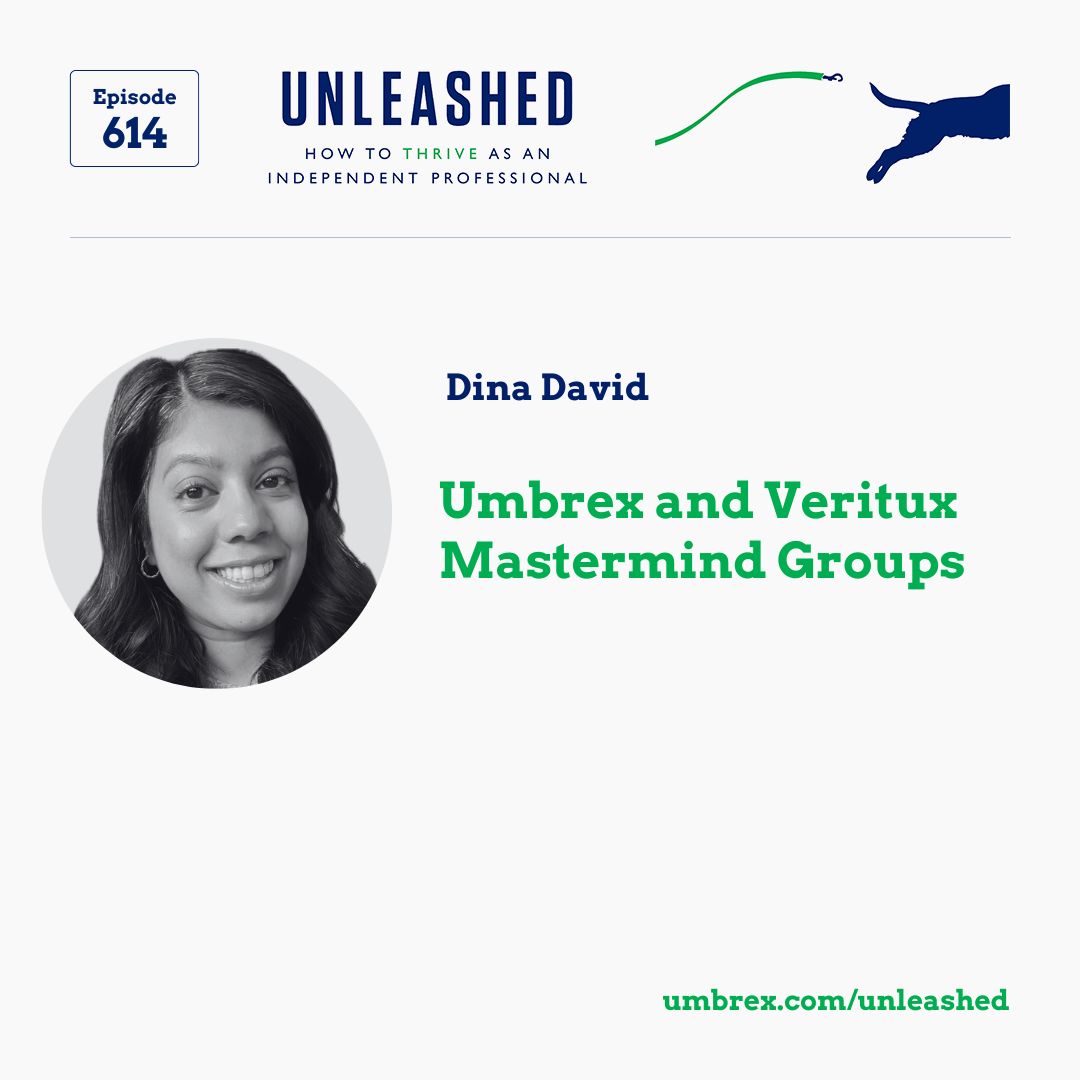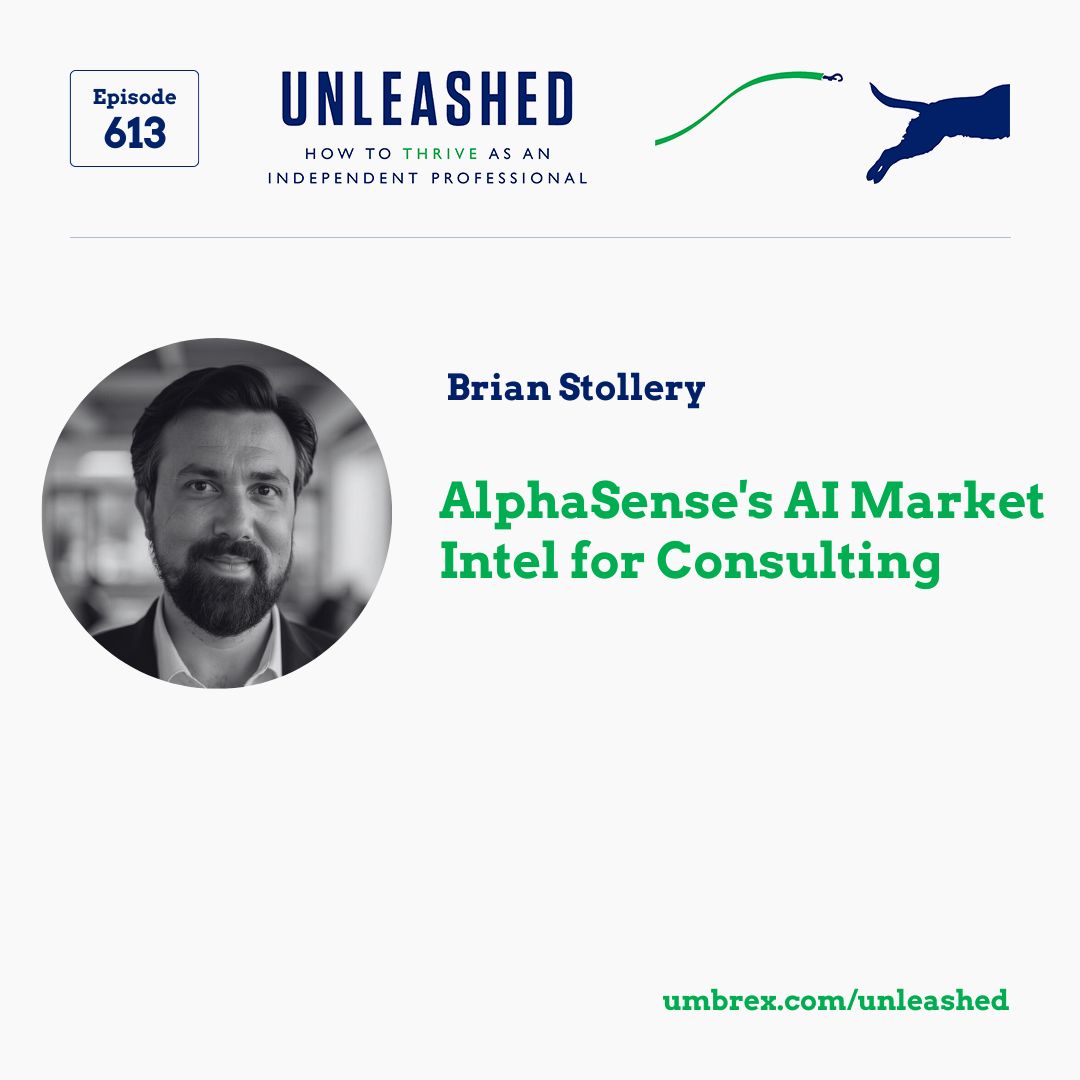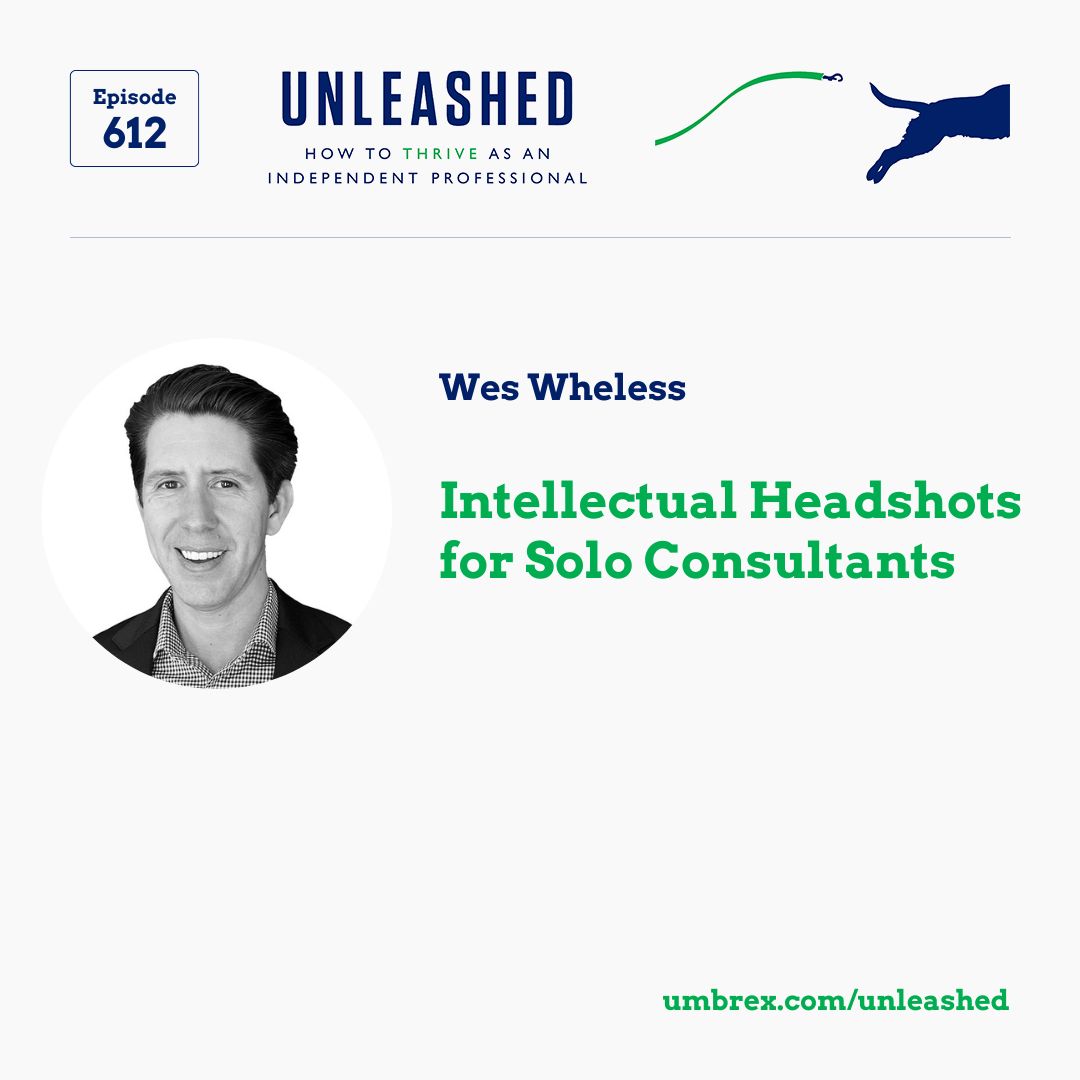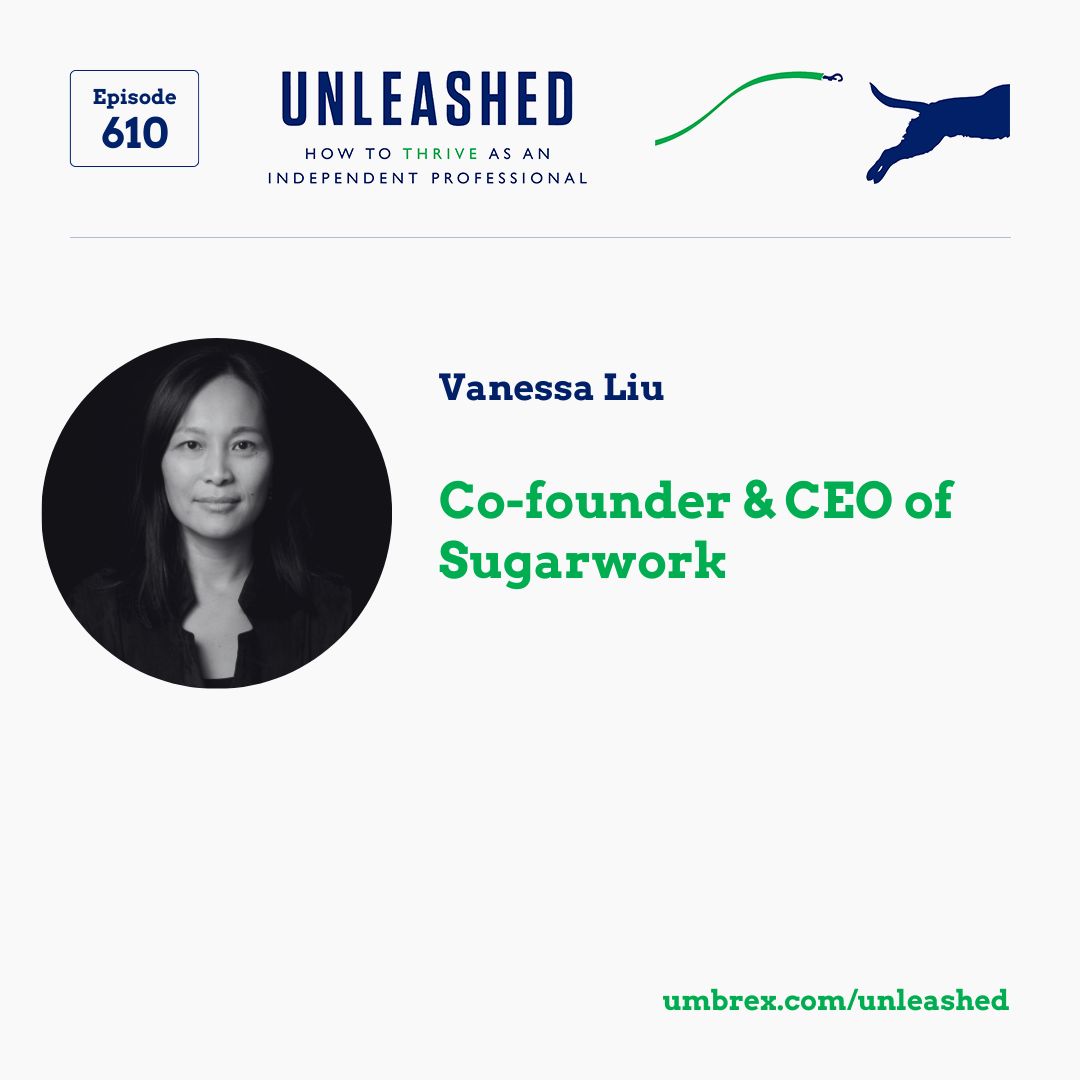Discover Unleashed - How to Thrive as an Independent Professional
Unleashed - How to Thrive as an Independent Professional

626 Episodes
Reverse
Show Notes: Bruno Strunz, lawyer, keynote speaker, and author of How to Sell Value in the Legal Market, shares his background, including his career path as a lawyer, including making partner and working for Volkswagen, and his extensive experience working with various companies and firms in both the legal departments and sales departments. Business Development for Professional Services Firms Bruno discusses his focus on business development for professional services firms, by selling in a structured and data-driven manner. Since 2018, he has been helping firms with what they have called the commoditization of quality and how to stand out in this competitive landscape. Bruno explains that his company initially focused on working with law firms for the last two years; they also started working with different types of professional services firms, including law firms, service orientated businesses, and consultancy companies. A Bespoke Approach to Business Development Bruno explains his approach to business development, starting with a diagnostic to understand the client base, churn, revenue generation, and distribution channels over the previous three years. He highlights the importance of expanding within existing client bases rather than focusing solely on new client acquisition. Bruno discusses the common challenges law firms face, such as low CRM adoption and the need for better data-driven decision-making. He emphasizes the importance of using CRM platforms effectively to improve sales processes and decision-making. Best Practice Approach for Growth Bruno outlines a best practice approach for growing within existing clients, starting with an 80/20 analysis to identify strategic clients. He looks at each business unit and asks if they have an account management plan for each unit, which means power mapping, stakeholder mapping, who's part of the decision-making process, assessing relationships, and understanding client goals for 2026. Bruno discusses the need for a SWOT analysis within specific accounts and the importance of looking for expansion opportunities. He highlights the challenges of client feedback in Latin America and the importance of guiding clients through their decision-making process. Differentiation in a Commoditized Market Bruno addresses the issue of differentiating in a commoditized market, where technical quality is no longer a competitive advantage. He emphasizes the importance of early engagement in the B2B buying cycle to avoid commoditization. Bruno discusses the role of relationship management, networking initiatives, and top-of-mind awareness in becoming the vendor of choice. He highlights the importance of bringing new insights and improving client experience to stand out in a competitive market. Client Success Stories Bruno shares a success story of working with a client in crisis management, focusing on educating the market and reframing their storytelling. He explains how the client successfully converted a multi-million dollar project during a major crisis. Bruno discusses another success story involving a proprietary framework to deep dive into client offerings and identify specific pain points. He highlights the importance of segmenting target lists, prioritizing outreach efforts, and bringing new ideas to clients. Bruno emphasizes the importance of consistency and discipline in business development strategies. Timestamps: 04:11: Business Development Strategies for Law Firms 10:43: Building a Programmatic Approach to Client Growth 14:49: Differentiating in a Commoditized Market 20:01: Success Stories and Client Impact 29:34: Final Thoughts and Contact Information Links: LinkedIn: https://www.linkedin.com/in/brunostrunz/ Website: https://strunz.com.br/ This episode on Umbrex: https://umbrex.com/unleashed/episode-628-bruno-strunz-how-to-sell-value-in-professional-services/ Unleashed is produced by Umbrex, which has a mission of connecting independent management consultants with one another, creating opportunities for members to meet, build relationships, and share lessons learned. Learn more at www.umbrex.com. *AI generated timestamps and show notes.
Show Notes: Rod Neuenschwander, author of From Crisis to Clarity and co-founder of GIFT·OLOGY, recounts his early days with John Ruhlin, their initial plan to buy companies, and their first turnaround experience. He also talks about the formation of Ruhlin Group and their transition to GIFT·OLOGY, focusing on corporate gifting. The Transition of Ruhlin Partners Rod talks about the development of Ruhlin Partners, a firm that helped companies through crises, and how it was the foundation for a new book project. He discusses John Ruhlin's sudden death and his immediate need to reconstitute the firm. He explains his initial struggle with gifting, his team's expertise, and the overall support from his team. Fulfilling a Promise and a Framework for Turnarounds The conversation turns to the idea of writing a book to fulfill a promise to John and provide a framework for turnarounds. He shares how John had been the top lead generator and how his crucial role in the firm left a large space to be filled. He explains the evolution of GIFT·OLOGY's philosophy and the development of the Beyond GIFT·OLOGY program. The Focus of GIFT·OLOGY Rod explains what GIFT·OLOGY is, how it works, and how it differentiates from other firms that play in this field. The focus is on personalized, non-promotional gifts to build relationships. He talks about the importance of reaching clients on a personal level and being present to clients' inner circles. He expands upon the acceleration of their platform and training program after John's passing, and how he managed the transition. A Relationship Operating System The interview moves on to the introduction of the Relationship Operating System to support leaders in building relationships, and Rod explains the components of the Relationship Operating System, including help identify, help connect, help equip, help track, help celebrate, and help scale. He talks about demonstrations of value, clarity conversations, and meaningful touchpoints through gifting. He also shares details about the development of a CRM plugin to support the training and execution of the Relationship Operating System and goes on to give a step-by-step explanation of the system. The Design of Connection Rod gives a detailed example of a client engagement, including the design of a connection plan, demonstration of value, how you communicate who you serve and how you serve, and gifting campaigns. He explains the role of GIFT·OLOGY in supporting leaders in their relationship-building efforts, and shares a detailed example of a client engagement, including the design of a connection plan and gifting campaigns. A Framework for Companies in Crisis Rod explains how he uses the same framework for GIFT·OLOGY as he does for other companies in crisis. He identifies the four types of crises: chronic underperformance, broken mirror, slow leak, and fire. Rod details the one-page recovery plan: clear purpose statement, go-forward operating plan, financial plan, and team plan. And he emphasizes the importance of moving fast with the plan and learning along the way. The Success of From Crisis to Clarity Rod talks about his book and his satisfaction with the feedback received for From Crisis to Clarity. He explains that the book's focus is on providing a simple framework for founders to navigate crises. He shares how the editing process was precise to ensure the book is concise and valuable for its target audience, and he shares his thoughts on the ongoing support and growth of GIFT·OLOGY despite the challenges faced. Timestamps: 04:05: The Impact of losing his business partner and friend. 09:53: GIFT·OLOGY's Unique Approach to Corporate Gifting 11:47: The Relationship Operating System and Client Engagement 20:48: Rod's Framework for Crisis Recovery 28:44: The Success of From Crisis to Clarity Links: LinkedIn: https://www.linkedin.com/in/rod-neuenschwander/ From Crisis to Clarity: https://fromcrisistoclarity.com/ GIFT.OLOGY Group: https://giftologygroup.com/ This episode on Umbrex: https://umbrex.com/unleashed/episode-627-rod-neuenschwander-author-of-from-crisis-to-clarity-and-co-founder-of-gift-ology/ Unleashed is produced by Umbrex, which has a mission of connecting independent management consultants with one another, creating opportunities for members to meet, build relationships, and share lessons learned. Learn more at www.umbrex.com. *AI generated timestamps and show notes.
Show Notes: Antonio Nieto-Rodriguez, a leading expert on project management, talks about his upcoming HBR book. Antonio shares his career path, including his time at PwC, banking, and pharma, and his early realization of the importance of project management. Changing the Perception of Project Management He discusses his mission to change the perception of project management from a tactical to a strategic role, including his work with the Project Management Institute (PMI) and his goal to publish in Harvard Business Review (HBR). Antonio highlights the challenges he faced in gaining recognition for project management as a most important facet of any organization, and his eventual success in publishing his second book with HBR. Antonio explains the key concept of his new book and shares how he pitched the idea to HBR, emphasizing that everyone is a project manager and that organizations should be project-driven. The Definition of Project Management Antonio mentions the success of his first book with HBR, which sold over 50,000 copies and was translated into multiple languages. He moves on to outline the theme of his new book: how every organization should become project-driven to adapt faster and transform constantly in a changing world. When asked to define what a project is, Antonio provides a classic academic definition of a project, emphasizing its start, end, objective, and teamwork. He then shares a more inspirational definition, stating that projects build the future of organizations and should be seen as essential and prestigious. He stresses the importance of project managers being proud of their work and the significant impact projects have on the future of companies. Project-driven vs. Operations-driven Organizations Antonio compares and contrasts project-driven and operations-driven organizations. He explains that most established companies are operations-driven, with operations at the core and projects as secondary. He also discusses the impact of the agile mindset, which broke down silos and hierarchies but still prioritized operations. Antonio introduces his model of a project-driven organization, where projects are at the core, teams are fully dedicated, and operations become more modular and secondary. Transformation from Operations-driven to Project-driven When offering tips on driving transformation from operations-driven to project-driven, Antonio identifies three main challenges: the organization's culture, the role of leaders, and the evolution of project management. He highlights the high failure rate of projects and the need for continuous transformation rather than continuous improvement, and emphasizes the importance of co-creation, bottom-up approaches, and the courage to stop projects that are not working. Managing Project Portfolios and Tracking Projects Antonio suggests conducting an inventory of all projects, identifying owners, and cutting a significant number of projects to focus on the most important ones. He recommends using project portfolio management (PPM) tools or simple Excel sheets to track projects. Antonio stresses the importance of prioritizing projects that lead to exponential growth and big bets rather than incremental improvements. When managing project portfolios and changing their management infrastructure, Antonio advises leaders to sponsor no more than three projects and to group projects into programs for better focus. He recommends having fully dedicated project teams where people leave their day jobs to focus on projects. Antonio explains that leaders should act more as coaches, empowering teams to take decisions and prioritize within projects. And finally, he emphasizes the importance of sharing knowledge and being open to exchanging ideas with others. Timestamps: 00:02: Antonio Nieto-Rodriguez's Background and Mission 04:08: Introduction to Powered by Projects 07:29: Defining Projects and Their Importance 09:05: Project-Driven vs. Operations-Driven Organizations 16:28: Challenges and Solutions for Project Management 22:28: Managing Project Portfolios and Prioritization 29:01: Empowering Project Teams and Leadership Links: LinkedIn: https://linkedin.com/in/antonionietorodriguez Business: https://projectsnco.com New Book: https://poweredbyprojects.com/ Other Books: https://www.amazon.ca/stores/author/B00CMECP0U HBR Articles: https://store.hbr.org/shop/?section=product&search_query=Antonio%20Nieto%20Rodriguez#/filter:categories:Articles This episode on Umbrex: https://umbrex.com/unleashed/episode-626-antonio-nieto-rodriguez-author-of-hbrs-powered-by-projects-leading-your-organization-in-the-transformation-age/ Unleashed is produced by Umbrex, which has a mission of connecting independent management consultants with one another, creating opportunities for members to meet, build relationships, and share lessons learned. Learn more at www.umbrex.com. *AI generated timestamps and show notes.
Show Notes: Samora Wolokolie talks about his dual roles as a CPA, CA and attorney in Monrovia, Liberia. Samora lists his credentials: chartered accountant, certified public accountant, certified forensic investigation professional, certified fraud examiner, certified tax practitioner, and lawyer, and details his academic background. He is also an assistant professor at the University of Liberia where he teaches all levels of accounting. Samora also teaches at other universities and holds graduate and post graduate degrees from Cuttington University, and Charisma University. He talks about his career path, including working with Deloitte in 2000, then moved to PKF Liberia and Baker Tilly, where he qualified as a chartered accountant in 2014. Serving as Liberia's Deputy Minister of Finance for Fiscal AffairsSamora served as Liberia's Deputy Minister of Finance for Fiscal Affairs from 2018 to 2024, managing the national budget and growing it from $600 million to $800 million. When asked about the major sources of revenue for the Liberian government, Samora explains that over 80% of the government budget comes from domestic revenue, with the rest from External resources (donors like the IMF, World Bank, and European Union). He details the importance of conducting audits and meeting benchmarks to access external resources and shares a few examples of how this works. Samora discusses his role in developing revenue policies and regulations, focusing on domestic resource mobilization to grow the budget to $1 billion. He highlights the challenges and strategies needed to achieve this goal, including tax policies and revenue measures. He goes on to explain the structure of the companies he currently works for, his roles there, and how it focuses on both accounting and legal issues. Major Industries and Economic Potential in Liberia The conversation turns to the main industries in Liberia. Samora describes Liberia as an input-driven economy with significant potential in mining, forestry, and infrastructure development. He mentions the mining sector's potential, including gold, iron ore, and diamonds, and the involvement of companies like ArcelorMittal. Samora also discusses the forestry sector's potential, including logs and the Kimberley Process. He emphasizes the government's efforts in infrastructure development, particularly road construction and building maintenance. He goes on to talk about investment potential and licensing, shipping, and exporting. Consulting and Legal Processes in LiberiaSamora talks about the process of hiring independent consultants in Liberia. He advises talking to an attorney and a CPA. He recommends checking with the Liberian Institute of Certified Public Accountants (LICPA) and the Liberian National Bar Association (LNBA) for licensed professionals. Samora explains the distinction between attorneys and counsellors at law in Liberia and recommends dealing with firms to ensure coverage through professional liability and insurance coverage. He goes into detail on the importance of following processes and doing due diligence and background checks when hiring consultants. Taxation and Labor Law Considerations for Foreign Companies Focusing on the tax implications for foreign companies hiring consultants in Liberia, Samora explains the withholding tax rates for resident and non-resident taxpayers, including the 10% and 15% rates for ordinary companies and the 6% rate for mining operations. He clarifies the concept of resident and non-resident status based on the number of days spent in Liberia. Samora discusses the importance of understanding Labor law considerations, including contracts, occupational health and safety, and long-term employment. He also explains the tax brackets and Social Security tax obligations for foreign companies, employees and independent contractors, in addition to labour laws and health and safety laws in Liberia. Insurance Requirements for Firms in Liberia. Samora advises firms to have professional liability insurance to cover potential transgressions. He emphasizes the importance of ensuring payments pass through formal financial institutions to avoid money laundering issues. Samora suggests using bank-to-bank wire transfers or prepaid cards for payments to consultants, and he reiterates the importance of due diligence and background checks when hiring consultants in Liberia. Timestamps: 04:11: Revenue Sources and Management in Liberia 09:38: Major Industries and Economic Potential 20:04: Consulting and Legal Processes in Liberia 27:08: Taxation and Labor Law Considerations 36:50: Insurance and Payment Methods Links: LinkedIn: https://www.linkedin.com/in/atty-samora-p-z-wolokolie-ph-d-cfe-ca-cpa-fcfip-l-l-b-67315438/ Alliance CPA Inc: https://alliancecpainc.com/ TORCH Professional Consultancy Inc: https://topcinc.com/ This episode on Umbrex: https://umbrex.com/unleashed/episode-625-samora-p-z-wolokolie-how-to-hire-a-consultant-in-liberia/ Unleashed is produced by Umbrex, which has a mission of connecting independent management consultants with one another, creating opportunities for members to meet, build relationships, and share lessons learned. Learn more at www.umbrex.com.
Show Notes: David Nour, author of Relationship Economics, discusses the six phases of strategic relationships. He emphasizes intentionality and a portfolio approach to relationship investing. The six phases he uses throughout the episode are: mapping, relating, nurturing, sustaining, requesting, and capitalizing. Different Levels of Relationship Management Nour explains that when a challenge arises, the first questions should be: Who do I need? Who do I know? How do I connect the dots? He contrasts haphazard outreach, simple lists, and CRM-driven discipline, underscoring the importance of intentionality and consistency. He highlights relationship mapping to achieve specific goals—beginning with identifying targets, nurturing, and sustaining relationships. In a pharma example, he shows how to identify key companies and contacts and introduces the ideal relationship profile—focusing on specific individuals (not logos) because relationships are built between people. He also stresses finding "lookalikes": individuals whose values are aligned, who value and respect the relationship. Cold Outreach to Build Relationships On building new relationships—especially via cold outreach—Nour recommends focusing on fewer but better-qualified leads: go where potential clients already are (e.g., micro-events), be more interested than interesting, and engage with thoughtful questions. Quick, consistent follow-up turns initial introductions into meaningful relationships. He shares specific questions he uses to spark valuable conversations and secure meetings. Initial Conversations in Relationship Building Nour critiques "intellectually lazy" openings like "Tell me about your situation." Instead, come prepared with a hypothesis based on research and use questions to set the agenda. Authenticity matters: each consultant should develop their own style. To avoid being forgettable, respectfully provoke prospects to think differently. Unpacking the Four Middle Phases Nour details the four phases that form the "engine" of relationship development: Relating: Share relevant stories so prospects see themselves in similar situations. Nurturing: Add value with ideas, checklists, and stress-testing to build trust and credibility. Sustaining: Maintain momentum over time; help the buyer buy; enable internal champions. Requesting: Earn the right to ask for deeper access (e.g., org charts, NDAs, stakeholder conversations) to better understand needs and increase impact. Capitalizing on Relationships After Project Completion Two-thirds of the way through a project, identify existing, impending, and created needs to link projects and avoid losing momentum post-delivery. Nour shares how he invites senior executives from one client to speak at another client's event (non-competing industries), creating an ecosystem of seasoned leaders who become walking case studies. Climbing the Relationship Value Pyramid Nour bridges the gap between recognizing the importance of relationships and harnessing their significance with three ideas: Intelligent Relationship Management: Set relationship-centric outcomes, identify pivotal contacts, and make consistent "favor economy" deposits. Strategic Relationship Planning: Map company-to-company relationships from now to next (champions, cadence, outcomes). Relationship Value Pyramid: Categorize by depth and relevance—situation, investment, portfolio, recall (2 a.m.)—and apply a portfolio approach with a "three-touch rule" before reallocating attention. Reciprocity in Relationship Building Nour reviews gratitude, reciprocity, and paying it forward as observable behaviors. Twice a year, he reviews his top 100 relationships to prioritize where to invest next. He also mentions Avnir, his AI platform that builds a private relationship vault from existing data sources and prompts context-relevant actions to deepen connections. Timestamps 05:40: Mapping & Ideal Relationship Profiles 10:20: Building New Relationships (Cold Outreach) 22:16: The Six Phases: Mapping, Relating, Nurturing, Sustaining, Requesting, Capitalizing 28:31: Capitalizing on Relationships 35:51: Relationship Economics Framework 42:34: Portfolio Approach & Three-Touch Rule 48:41: Activating the Untapped Power of Relationships Links Professional Services Website: DavidNour.com AI Platform Website: Avnir.com Nour on LinkedIn: https://www.linkedin.com/in/davidnour/ This episode on Umbrex: https://umbrex.com/unleashed/episode-624-david-nour-author-of-relationship-economics/ Unleashed is produced by Umbrex, which has a mission of connecting independent management consultants with one another, creating opportunities for members to meet, build relationships, and share lessons learned. Learn more at www.umbrex.com.
Show Notes: Kartik Sundar, founder of TeamSlide, a tool that uses AI to create PowerPoint slides, explains that TeamSlide is available through a web browser and a PowerPoint add-in, with users starting in the web browser and eventually using the add-in for more seamless access. A Demonstration of TeamSlide Kartik demonstrates how TeamSlide converts notes into consulting-style slides using AI for visual design and text layout. He explains the chat interface-like layout and the ability to generate multiple slide layouts from the same content. TeamSlide identifies the best layout for the story and structures it accordingly, using the example of four takeaways. Users can select specific layouts and input data, which TeamSlide will then convert into the chosen template. Features and Customization of TeamSlide Kartik shows how users can be more prescriptive by selecting specific layouts and inputting data, which TeamSlide will then convert into the chosen template. Kartik explains that TeamSlide considers the size of text boxes and edits sentences to fit within them, maintaining the look and feel of the slide. He pulls data from ChatGPT to demonstrate how TeamSlide adapts the information to the slide deck. When asked about using personal PowerPoint templates, Kartik explains that while independent users cannot insert their own templates, TeamSlide's templates are designed to be transferable to any PowerPoint template. Kartik mentions that consulting firms and enterprises can specify their templates and layouts, which TeamSlide will then adapt to fit their brand and voice. Exploring Templates and Features Kartik demonstrates the variety of templates available in TeamSlide, including flows, executive summaries, data visualization, and specialized slides like maturity curves and funnels. Kartik talks about the different templates, noting the advanced manipulation capabilities of TeamSlide, such as restructuring slides in complex ways to meet specific needs and uses building an org chart with specified team members as an example. Kartik explains that independent consultants can access TeamSlide for free, while enterprises can tailor the solution to their brand and voice for a fee. PowerPoint Add-In and AI Assistant Kartik demonstrates the PowerPoint add-in, which is available in Microsoft's app source and integrates seamlessly with PowerPoint for a more streamlined experience. When asked about the integration of personal PowerPoint templates, Kartik explains that the add-in will transfer the color scheme and styling of the user's template. He also mentions the search function in TeamSlide, which allows users to find slides in their knowledge repository, such as SharePoint or Box. History and Evolution of TeamSlide Kartik provides a brief history of TeamSlide, starting with a deep slide search tool in 2014 and evolving to include AI-generated slides and the training data used to develop the tool. TeamSlide was initially designed for consulting firms to improve the process of finding and creating slides, and later expanded to serve marketing and sales teams. The AI aspect of TeamSlide was developed after testing internally to see what features would be most valuable to their audience. Integration of Brand Voice Kartik highlights the importance of tailoring the solution to the brand and voice of consulting firms and enterprises, ensuring that the slides fit their specific needs.The conversation summarizes the various features and benefits of TeamSlide, including the ability to generate slides with specific layouts and data, and the advanced manipulation capabilities. The pricing for enterprises depends on the number of users and includes customization charges. Timestamps: 00:02: Overview of TeamSlide 02:08: Demo of TeamSlide in the Browser 04:52: Advanced Features and Customization 07:05: Exploring Templates and Features 11:39: PowerPoint Add-In and AI Assistant 17:27: History and Evolution of TeamSlide Links: https://create.teamslide.com/ This episode on Umbrex: https://umbrex.com/unleashed/episode-623-kartik-sundar-teamslide-a-free-ai-tool-for-generating-consulting-style-ppt-slides/ Unleashed is produced by Umbrex, which has a mission of connecting independent management consultants with one another, creating opportunities for members to meet, build relationships, and share lessons learned. Learn more at www.umbrex.com.
Show Notes: Brian Potter, author of The Origins of Efficiency, explains his core model of efficiency, which includes five levers: production method, increasing production rate, lowering input costs, removing steps, and reducing variability. The Work behind the Book Brian discusses his background in the construction industry and his initial struggles in writing the book, including difficulties in explaining his thesis simply and coherently and the inspiration behind writing the book. He describes his process of iterating and refining his ideas, eventually classifying various strategies for improving productivity into a few key buckets. Economies of Scale in the Construction Industry The conversation turns to the book's argument that construction costs have not decreased, contrasting it with other manufactured goods. Brian explains the unique challenges in achieving economies of scale in construction, such as the difficulty in transporting buildings and the high costs of building materials and labor. He discusses the historical lack of economies of scale in large home builders and the challenges posed by different building codes, permitting jurisdictions, and environmental requirements. Brian emphasizes the difficulty of reducing input costs in construction due to the fixed nature of building materials and labor costs and explains how it compares to other industries and products. How Transport Impacts Costs in Construction The book explores the importance of reducing transport costs for efficiency gains, and Brian explains how the development of railroads in the 19th century enabled large-scale production by reducing transport costs and improving reliability. He discusses the impact of container shipping on modern manufacturing, highlighting the cost advantages of larger container ships due to geometric scaling and fixed cost scaling. Brian also mentions the historical example of iron stoves becoming more common after the development of railroads, which made it economical to transport them long distances. How Changing Production Methods Reduce Cost Brian is asked for an example of how changing production methods can unlock efficiency, and he talks about the discovery of a new process for making steel, which dramatically reduced the cost and time required to produce steel compared to the cementation process. He explains how the Bessemer process allowed for the widespread use of steel in construction, enabling the construction of buildings with steel frames. Brian highlights the importance of technological advancements in reducing the cost and increasing the efficiency of production methods. Examples of Efficiency Gains: Increasing Production Rate When asked for an example of how increasing production rate can lead to efficiency gains, Brian refers to container shipping, where larger ships have reduced costs per container due to geometric scaling and fixed cost scaling. He explains how spreading fixed costs over a larger output can make production more efficient. Brian mentions the example of Japanese factories in the 1980s, which were cheaper to build because they needed to store less inventory due to lean manufacturing principles. How Lowering Input Costs Leads to Efficiency Gains Brian explains how thread is an example of how lowering input costs can lead to efficiency gains. Thread became much cheaper due to technological advancements in spinning and weaving. He explains how cheaper inputs can lead to lower costs in the final product, making it more affordable for consumers. Brian also mentions the example of Iceland producing a large amount of aluminum due to its cheap hydroelectricity, which is a significant input cost in aluminum production. Improving Efficiency Gains by Removing Steps Brian shares an example of removing unnecessary steps in the production process at Tesla, such as removing sound-absorbing mats in the car that did not add value and the robots were having great difficulty installing. When they ran tests they found the mats didn't actually improve noise reduction. Brian explains how minimizing unnecessary steps can reduce costs and improve efficiency. He talks about common steps that can be removed ,and the importance of minimizing inventories and buffers in lean manufacturing to reduce costs and improve flow. Reducing Variability to Improve Efficiency Gains Brian discusses the example of semiconductor manufacturing, where reducing variability can significantly increase yields and reduce waste. He explains how precise control of the manufacturing process can lead to more reliable and efficient production. Brian mentions the importance of reducing errors and failures in production processes to improve efficiency and reduce costs. Evolution of Construction Physics Brian explains how his Substack started focusing on construction and housing but expanded to include topics like the energy grid, energy tech, institutions, innovation dynamics, and global production. He explains how his work at a construction startup influenced the topics he covered in the Substack, and how he began by just following his interests. However, later a thinktank became a fan of his Substack and sponsored him. Brian also mentions the support he received from the Institute for Progress, which helped him expand his reach and focus on broader topics. The Role of Institutions and Organizations as a Production Technology Brian explains that organizations and the way work is structured can be a significant factor in productivity improvement. He discusses the importance of lean manufacturing and other industrial improvement methods in rearranging work to improve efficiency. He also mentions that organizations and their patterns and behaviors can embody important technological knowledge and practices. Research and Primary Sources Brian shares that he is primarily a text-based researcher and relies on books, manuals, and other written sources for his research. He explains that his experience working in the construction industry informs his understanding of different industries and production methods. He also discusses the importance of finding sources that provide detailed information about production processes and technological advancements, and why he doesn't talk to much about manufacturing in China. Future Plans and Final Thoughts Looking ahead, Brian has ideas for new books, including a short history of the shipbuilding industry. He also discusses his ongoing work on the Substack Construction Physics and his focus on following his interests and learning more about various topics. Timestamps: 00:02: Origins of Efficiency: Introduction and Core Model 05:07: Challenges in Construction Efficiency 09:37: Transport Costs and Economies of Scale 14:10: Examples of Efficiency Gains: Production Methods 18:55: Examples of Efficiency Gains: Increasing Production Rate 21:16: Examples of Efficiency Gains: Lowering Input Costs 24:10: Examples of Efficiency Gains: Removing Steps 27:38: Examples of Efficiency Gains: Reducing Variability Links: Substack: Construction Physics (embedded link on that phrase should be: https://www.construction-physics.com/p/my-book-the-origins-of-efficiency?r=oq1t&utm_campaign=post&utm_medium=web&showWelcomeOnShare=false The Book: The Origins of Efficiency (link should be: https://amzn.to/3IN38ii Unleashed is produced by Umbrex, which has a mission of connecting independent management consultants with one another, creating opportunities for members to meet, build relationships, and share lessons learned. Learn more at www.umbrex.com.
Introducing EVE This episode kicks off with an introduction to EVE, an AI operator that turns email inboxes into lead generation. Founder Vadim Rogovskiy explains that EVE helps small businesses organize their inboxes to find leads and follow-ups. EVE saves time by drafting personalized emails and flagging upsell or churn signals. He mentions the special pricing: $250 per month for an individual plan and $500 per month for a team plan. EVE offers a seven-day trial, a refund for the first month, and a risk-free first month. Vadim also provides information on how to find more information about EVE online and on LinkedIn. EVE for Independent Consultants The conversation highlights how EVE can be useful for independent consultants who manage their own sales and work. Vadim explains that EVE requires minimal onboarding; users just need to connect their corporate email. EVE integrates with Google and Microsoft for privacy and security, and EVE builds a knowledge graph about the business by analyzing years of email data and internet-based research. Functionality and Features Vadim describes how EVE classifies contacts and extracts customer profiles from email data and public databases. EVE analyses communication to adopt tone and style, and provides an executive summary of the business to filter and prioritize leads. EVE flags leads that fit the ideal customer profile and provides necessary context for follow-ups and analyzes and prioritizes urgency. EVE can draft emails in the user's style and automate bespoke responses based on previous email history. Automated Re-Engagement of Cold Leads When asked about re-engaging cold leads that have not responded in months or years, Vadim explains that EVE can suggest templates for re-engaging cold leads. EVE's vision includes automating communications to handle a majority of leads without human intervention. EVE can schedule calls, draft contracts, and answer questions based on the company's knowledge base. EVE's Capabilities in Action. Vadim shares his screen and logs into EVE using his corporate email. EVE displays new opportunities and follow-up leads, providing context and recommended actions. EVE shows a full history of communication with leads and allows filtering by various criteria. Timestamps: 00:02: Overview of EVE 01:28: Use Cases and Onboarding Process 04:28: Detailed Functionality and Features 06:40: Re-Engaging Cold Leads 10:25: Demonstration of EVE's Capabilities 13:49: Pricing and Availability Links: Website: joineve.ai LinkedIn: https://www.linkedin.com/in/vadim-rogovskiy/ This episode on Umbrex: https://umbrex.com/unleashed/episode-621-vadim-rogovskiy-founder-of-eve/ Unleashed is produced by Umbrex, which has a mission of connecting independent management consultants with one another, creating opportunities for members to meet, build relationships, and share lessons learned. Learn more at www.umbrex.com.
Show Notes: Christian Derosier, co-founder of Flashpoint.ai, explains that it is an AI-native market research agency that offers tools and methods typically used by market research agencies but at a fraction of the time and cost. Flashpoint.ai includes surveys, media monitoring, expert calls, and proprietary tools, aiming to provide a comprehensive market research solution. The tool is designed to help business leaders and consultants live at the level of business problems, clarifying objectives and translating them into a coordinated set of tools. Demonstrating Flashpoint.ai Features Christian shares his screen to demonstrate the tool, starting with a generic research query about market trends related to lactose-free ice cream in the United States. The tool generates an AI web overview, providing initial context and a research plan, including sections on growth drivers, consumer preferences, competition, and barriers to scale. Users can edit and add new sections to the research plan, and the tool provides an AI assistant for further context and detail. The action plan translates the high-level objective into specific tools, such as surveys, expert interviews, and generative R&D testing. The Generative R&D Tool Christian explains the generative R&D tool, which conducts market testing by running ads to evaluate interest and demand for products. The tool generates ads and landing pages, allowing users to observe real consumer behavior and preferences. The ads are deployed on Google Ads, and the landing pages provide real information and links to actual products or services. The tool is useful for concept testing, new product development, and disruptive innovation, as it allows testing without attaching real brand names. Generative R&D Case Study Christian shares a case study where a small liberal arts school used the generative R&D tool to test different marketing strategies. The school tested various concepts, including study abroad offers, practical applications of liberal arts degrees, and even anti-woke liberal arts schools. The tool helped the school identify latent demand and insights into future planning. The cost for running the ads and generating insights is relatively low, making it an efficient and cost-effective method for market research. Flashpoint.ai Licensing The base fee for a Flashpoint.ai license is $40 per month per user, billed annually at $480. Additional costs come from sample sizes, ad runs, expert calls, and other project-specific expenses. Users can purchase resources a la carte for each project, avoiding long-term commitments. The tool is available on flashpoint.ai, and additional resources, such as sample deliverables and video walkthroughs, can be provided upon request. Timestamps: 0:02: Overview of Flashpoint.ai 04:07 Live Demo of Flashpoint.ai 11:29: Generative R&D Testing 21:41: Case Study and Insights 23:50: Pricing and Availability Links: Website: https://www.flashpoint.ai/ This episode on Umbrex: https://umbrex.com/unleashed/episode-620-christian-derosiers-co-founder-of-flashpoint-ai/ Unleashed is produced by Umbrex, which has a mission of connecting independent management consultants with one another, creating opportunities for members to meet, build relationships, and share lessons learned. Learn more at www.umbrex.com.
Show Notes: Uday Turaga runs ADI Analytics, a boutique firm specializing in oil and gas, energy, and chemical industries. ADI Analytics was founded in 2009, has 20 employees, and operates globally. The firm focuses on the value chain across oil and gas, energy, and chemicals, including upstream exploration, midstream natural gas and LNG markets, downstream fuels, power utilities, and energy transition. In 2017, ADI Analytics acquired Chemical Market Resources, expanding its capabilities in the chemicals and materials spaces. Oil and Gas Projects Uday discusses various oil and gas projects, including work with large oil and gas majors like Exxon, BP, and Shell. ADI Analytics helps refining independents explore export markets in Latin America due to the US refining complex's gasoline surplus. The firm conducts feasibility studies for LNG export terminals on the US Gulf Coast, analyzing competitive positioning, technology, risks, and financing. He explains that scenario planning for an oil major focuses on long-term energy demand, and how it can be affected by the growing demand for natural gas from data centers and emerging markets globally. About ADI Analytics Uday talks about ADI Analytics. They work with large chemical players like BASF, Dow, and SABIC, covering the entire value chain, and help them on the feedstocks conversion into key building blocks in the chemicals industries, such as olefins, aromatics, and then all the derivatives, and further down into plastics, polymers and and how those plastics and polymers end up in our lives as consumers. He explains why the chemical industry is distressed, and how the firm helps clients understand the cost competitiveness of different chemicals globally and the impact of energy transition on the industry. Projects include due diligence for private equity firms on specialty chemical and materials markets and mapping the impact of energy transition on supply chains. Data Center Growth in the US Uday provides an overview of the data center landscape, noting the significant growth in data center capacity in the US Hyperscalers are building larger data centers, often in non-traditional locations like Texas, Oklahoma, and Louisiana, driven by the need for secure energy and power. He explains how large the demand for electricity from data centers is with hyperscalers requiring up to a gigawatt of power, which is challenging to secure. Energy needs between households and data centers are compared to give an example of the scale needed. However, the process of adding new power generation capacity to the grid is slow, with interconnection queues taking multiple years, leading to delays in meeting data center power needs. Energy Sources and Strategies for Data Centers Hyperscalers are pursuing various strategies to secure power, including building data centers in non-preferred locations, partnering with utilities, and investing in early-stage technologies like geothermal and small modular nuclear reactors. Uday discusses the challenges of securing power for data centers, including the need for significant new power generation capacity and the difficulties in connecting to the grid. The conversation highlights the importance of low-carbon energy sources for data centers, with interest in geothermal, nuclear, and hydrogen. ADI Analytics is involved in projects helping tech companies identify sources of low-carbon energy and exploring opportunities for oil and gas majors in the power generation space. Geothermal Energy and Small Modular Nuclear Reactors Uday explains the potential of geothermal energy, including traditional hydrothermal resources and advanced geothermal systems (EGS). EGS involves drilling deep into the Earth's surface to extract heat, but the technology is still in development and faces challenges like high costs and engineering complexities. Small modular nuclear reactors (SMRs) are gaining interest due to growing electricity demand from data centers and industrial electrification. The conversation covers the regulatory and permitting challenges for SMRs, the need for innovation in nuclear power, and the potential for these technologies to address energy needs. Politics and Policy on Energy Projects The conversation turns to the impact of political and policy decisions on energy projects, including the opposition to renewable energy projects and support for nuclear power. Uday highlights the need for a balanced energy policy that supports all forms of energy, recognizing the unique advantages and challenges of each technology. He emphasizes the importance of allowing markets to determine the most competitive energy solutions, rather than imposing political or regulatory barriers. The discussion concludes with a call for a more cohesive and market-driven energy policy to meet the diverse energy needs of the future. Timestamps 02:22 Oil and Gas Project Examples 04:56: Chemical Industry Projects 08:16: Data Center Trends and Challenges 23:45: Energy Sources and Strategies for Data Centers 25:28: Geothermal Energy and Small Modular Nuclear Reactors 33:18: Political and Policy Considerations Links: ADI Analytics website: www.adi-analytics.com LinkedIn: https://www.linkedin.com/in/turaga/ Unleashed is produced by Umbrex, which has a mission of connecting independent management consultants with one another, creating opportunities for members to meet, build relationships, and share lessons learned. Learn more at www.umbrex.com.
Show Notes: David A. Fields talks about how AI is affecting consulting firms. David clarifies that his company's active client base is 30-50 firms, and they are being asked more frequently to help firms with an AI strategy. In terms of size, 20% of their business is solo consultants, while the rest are mostly businesses that range from $2 million to $100 million. Consulting Firms and AI Adoption David explains that the average revenue per FTE in consulting has remained around $250,000 for the past decade.He notes that firms are looking to create the same revenue with fewer people, which is the big promise of AI. He mentions the wide range of AI adoption rates among firms, from those just starting with chatbots to those seeing significant productivity gains. He also highlights the impact of AI on hiring junior people, with firms debating whether to hire junior analysts or use AI for faster, cheaper work. How High-Adopter Firms Use AI The conversation turns to examples of high-adopter firms and the tools they use. David describes a Canadian client that has seen 60% productivity gains by replacing functions with AI, including analysis, presentations, and proposals. The client has taken a hard line on not hiring anyone if AI can replace the function, leading to significant productivity gains and faster client results. David explains that the client uses AI to create summaries of context discussions, and templates for presentations and proposals, which are then populated with data. Additionally, AI speeds turnaround time, and has reduced the need to hire more people to do analysis or when the number of clients increases. Challenges and Opportunities in AI Adoption David discusses the challenges of creating effective AI templates and the importance of good direction for AI tools. He mentions that firms are often building AI templates in-house with some direction from experts. He talks about the variety of AI tools available, including general-purpose tools like ChatGPT and specialized tools for specific tasks. David emphasizes the importance of staying flexible and not fully committing to any one tool by subscribing to an annual membership, as the landscape is constantly changing. Variation in AI Adoption by Functional Areas The discussion moves on to variations in AI adoption by functional areas like strategy, operations, marketing, etc. David explains that adoption rates are more driven by the founder's mindset and operational orientation rather than the specific function. He notes that some industries feel less pressure to adopt AI, while others recognize that AI delivers the analytical horsepower that is needed to stay relevant. There are varying levels of AI adoption across different firms. Predictions for AI in 2026 David predicts that the next few months will be spiky, with specialists who can provide practical applications of AI faring better. He mentions that generalist recommendation givers may struggle more. It is recognized that clients often prefer consultants with specific industry experience, which can be a challenge for AI tools. He also mentions the limitations of AI research. When it comes to advice for junior consultants looking to enter the field, David suggests that domain expertise and knowledge that AI tools don't have are crucial for getting into consulting firms. He emphasizes the importance of being a top user of AI tools and for junior consultants to differentiate themselves by mastering AI tools and demonstrating their value to firms. Timestamps: 02:40: Impact of AI on Hiring and Revenue in Consulting Firms 05:59: Specific AI Tools and Practices in High-Adopter Firms 11:12: Challenges and Opportunities in AI Adoption 14:56: Variation in AI Adoption by Functional Areas 19:26: Predictions for AI in 2026 and Beyond 21:06: Advice for Junior Consultants Links: Website: DavidAFields.com. Unleashed is produced by Umbrex, which has a mission of connecting independent management consultants with one another, creating opportunities for members to meet, build relationships, and share lessons learned. Learn more at www.umbrex.com.
Show Notes: Sri Kaza is a former McKinsey partner and the author of Unconvention, A Small Business Strategy Guide. Sri explains why he left McKinsey after nearly a decade of working with large corporations, to start working with small businesses. Around 12 years ago he decided to pursue entrepreneurship and independence. He worked for Tor Hagen at Viking Cruises, who was a former McKinsey partner, and Sri was impressed by Tor's ability to allow his vision to take risks and drive decision-making. This inspired Sri to look more broadly at entrepreneurship. The Tax Credit Company After working with Hagen, Sri joined a new entrepreneurial venture, the Tax Credit Co., which focused on small businesses with less than 100 or 500 employees. His focus was operationalizing their work opportunity tax credit business, helping them access the government credits they simply were not aware of. Sri's company spent a significant amount of time and money acquiring customers, focusing on providing value and helping them navigate the complex world of tax credits. Explaining The Work Opportunity Tax Credit Sri explains how The Work Opportunity Tax Credit, which allows small businesses to claim tax credits up to 2000 dollars for hiring individuals on government assistance or from unique districts with socio-economic issues. Sri talks about the scale of tax credit opportunities available as well as the potential for fraud and exploitation. To build a scalable back end, Sri drew from his McKinsey experience and suggests thinking about the business from the perspective of the small business owner and providing guidance on where the big problems are. Small Business Lending Sri shared examples from his most recent role as CEO of ForwardLine Financial, a small business lender about being informative and helping businesses research their problems. This approach helped both the small business clients and Sri's company scale up well; but many of their clients' business faced challenges during the COVID pandemic and a third of their customers did not survive the pandemic. Sri then developed a framework for building business cases and understanding the strategies of small firms, helping them apply funds and succeed. It was this experience that inspired the concept of his book. Agility and Speed of Decision-Making Incorporating agility and speed of decision making into a small business framework is crucial for success. Small business owners have the advantage of knowing their customers day-to-day and making decisions quickly. This is different from CEOs of big companies, who have to make decisions based on government restrictions. Sri explains that, during the post-COVID period, many businesses didn't wait to set up their standards for their in-store experience. They adjusted their offerings based on customer preferences, even in states with more freedom. For example, in Florida and Texas, businesses with a large number of operations struggled and saw higher revenue declines on average than some California cities. Business owners in these states didn't wait for the government to dictate their practices, but instead understood their customers' concerns and did their own research. This allowed them to make decisions quickly and reflect their customers' preferences, which helped them stay in better shape than chains that were waiting for national rules. The Importance of Purpose and Pride for Small Businesses Sri discusses the concept of purpose in small businesses, comparing it to the concept of Shokunin, or craftsmanship. Sri talks about his time in Japan and what he learned from small businesses there. He found that these businesses focused on their craft rather than profit or growth. He later realized that purpose allows individuals to choose their return on investment and pursue their passions. Individuals often leave consulting to pursue independence, not to make more money. They value the freedoms they gain from doing so. When making decisions, it's crucial not to compromise on their purpose, as it's powerful and doesn't have to follow the path of larger corporations. Pricing for Small Businesses Sri discusses the concept of raising prices for small businesses, which can be a challenge. He explains that there is more to understanding customer value than just price, and that small businesses should be conscious of the benefits they are sharing. He suggests that small businesses should not solely focus on profit but also on what they are trying to accomplish. He lays out pricing principles in his book to help small businesses understand how to calculate pricing and be conscious of the driving factors behind it that may not simply be profit. Plans for the Future Sri's personal plans for his book include becoming a coach or consultant to small businesses, launching a nonprofit foundation, and having an impact on 30 million entrepreneurs in the country. He believes that these entrepreneurs are challenged and need advice from people who have practical experience. He plans to create a nonprofit foundation and help build tools and reach a wider distribution. Timestamps: 02:15: Sri Kaza's Background and Entrepreneurial Journey 03:52: Challenges and Successes in Small Business Consulting 08:02: The Concept of Underdog Principles 22:40: Purpose and Craftsmanship in Small Businesses 26:27: Agility and Speed in Small Business Decision-Making 27:03: Value and Pricing in Small Businesses 28:42: Future Plans and Impact of the Book Links: Website:https://sri-kaza.com Gift for Unleashed Listeners: https://sri-kaza.com/media/unleashed Substack: https://substack.com/@srikaza?utm_source=global-search The Book: https://www.amazon.com/Unconvention-Small-Business-Strategy-Guide-ebook/dp/B0FM41LNWX?ref_=ast_author_mpb Unleashed is produced by Umbrex, which has a mission of connecting independent management consultants with one another, creating opportunities for members to meet, build relationships, and share lessons learned. Learn more at www.umbrex.com.
Show Notes: Sandor Marton, a McKinsey alum and co-founder of Chronos Insights introduces the AI research companion tool and explains its features. Sandor shares his background in growth strategy, commercial strategy, and due diligence work. He identifies the problems faced by small firms and independent practitioners who don't have large teams in place to assign people to do the massive amount of necessary foundational research, which limits the size of projects they can take on. An Overview of Chronos Insights Sandor discusses partnering with Matt Jones and Dustin Chrysler to develop an AI-powered solution for market and competitive landscape research. He talks about the background of the team and the issues they initially tackled. The team aimed to create a specialized prompt leveraging ChatGPT's large language model while moving away from ChatGPT's programming "to make people happy" and to deliver more accurate results. They developed their tool, Chronos, with a different approach. The tool uses neural search and keyword search to provide more accurate and sourced research solutions. Sandor talks about how they tested the agents. He found it saved 75% of research time using the platform and emphasizes the need for review and revision of AI-generated outputs. Chronos Research Capabilities The conversation turns to access to proprietary databases, and Sandor explains the current use of the alpha version sources publicly available information. He also talks about their engineering resources and can build a version that taps into proprietary, private, or licensed resources, and that the user can direct the agent to source from specific sources. Sandor refers to a large Fortune 100 company that has hired them to build an agent to work with their internal research team. Sandor discusses potential future features like an interview finder tool and a composite self-referencing insights feature. The discussion touches on the flexibility of the tool in handling different types of research problems. User Interface Explained Sandor explains the simple UI of the tool, which includes five landing pages: Project Overview, Research Statement of Work, Research Plan, Research Tab, and Research Summary. The tool creates a research plan based on the user's research statement of work, breaking it down into discrete task prompts. Sandor demonstrates how to use the tool by copying and pasting a Word document into the Research Statement of Work tab. The tool generates a detailed research plan, including market landscape, competitor landscape, and key trends and developments. Project Overview Research Plan Generation Sandor explains the process of generating a research plan, including organizing research tasks by major research categories and subsections. He shares an example of the various categories to be researched within the statement of work. The tool creates task prompts for each topic within the research statement of work. Users can edit tasks and change the language model used for research. Sandor highlights the efficiency of running multiple tasks concurrently using the platform and demonstrates how it works and the various categories of research that can be explored, analyzed, and summarized. How Chronos Summarizes Prompts Sections Identified and Tasks to Complete Subsections Explained Reviewing and Exporting Sandor demonstrates how to review and export the research outputs generated by the tool. The tool provides citations for each task, allowing users to verify the sources. Users can rerun tasks and edit them as needed. The tool offers a research summary feature, which condenses the research outputs into a concise format. Research Task Overview Market Landscape Research Use Cases and Future Developments Sandor talks about use cases and future developments. He explains that it can handle various research topics and how they have programmed the agent to eliminate errors. Sandor mentions a project which included researching sales cycles and client selection criteria. The tool has potential for developing primary research, valuation and diligence work, and incorporating proprietary or licensed material. Timestamps: 02:44: Development of the AI Research Companion 05:42: Current and Future Features of the Tool 08:55: Walkthrough of the AI Research Companion Tool 18:54: Detailed Explanation of the Research Plan 25:22: Running and Reviewing the Research Plan 33:20: Future Developments and Use Cases 37:20: Conclusion and Contact Information Links: Website: https://www.chronosinsights.com/ Unleashed is produced by Umbrex, which has a mission of connecting independent management consultants with one another, creating opportunities for members to meet, build relationships, and share lessons learned. Learn more at www.umbrex.com.
Show Notes: Sid Masson, co-founder and CEO of Wokelo.ai explains that Wokelo is an agentic platform for investment research and commercial due diligence, automating market research and desk research activities performed by consulting firms, investment banks, private equity analysts and so on. It offers private market research and allows the user to pass through hundreds and 1000s of data sets in a matter of minutes, but beyond just research, it automates end-to-end deliverables, all the way to a well formatted PowerPoint deck in a format of your choice. How Wokelo.ai Works Sid mentions that Wokelo has been in production for two and a half years and commercially launched in November 2023. The platform has 40+ paying customers, including big four consulting firms like KPMG, investment banks, and venture capital firms. Pricing starts at $30,000 annually for five seats and proportionate usage. Sid explains that larger enterprises use bespoke models which cost more and cases where certain boutique consulting firms who may not have may not need five or 10 seats and are offered customized pricing. Wokelo also ensures various security levels, including SOC 2 compliant cloud, private cloud instances, and on-prem deployments. A Demonstration of Wokelo Sid explains Wokelo's web application, which offers several workflows for different tasks. The platform includes standardized workflows like company research, industry research, and market maps, as well as custom workflows designed by users. He demonstrates the process of creating a live report for a company, including adding company attributes, uploading files, and generating insights. The platform generates a detailed, editable notebook with insights, sources, and charts, which can be exported in various formats. Sid lists the data sources Wokelo uses, including third-party data partnerships, public data scraping, and user-uploaded data. The platform has partnerships with CrunchBase, PitchBook, SNP Cap IQ, and IEP Query for patent data. Wokelo's proprietary private company database includes detailed information beyond firmographics, such as product catalogs and management profiles. Wokelo's Custom Workflow Feature Sid explains the custom workflow feature, which allows users to design their own bespoke workflows to mimic their existing methodologies. Custom workflows can include custom analysis, synergy potential mapping, and IC memos, tailored to specific user needs. The platform's user interface is designed to be easy to use, with guardrails and standardized constraints to ensure high-quality outputs. Wokelo's editable notebooks and charts are designed to be user-friendly and customizable, allowing for detailed and professional reports. The Wokelo Team Sid shares the background of the Wokelo team, including his and his co-founder's experience in management consulting and AI. The team has grown from 10 to 25 members in the last 12 months, with a focus on building a solid product and team. Wokelo has raised two rounds of funding: a pre-seed round in 2023 and a seed round in September 2022, totaling $5.5 million. The funding has helped the team build a solid product and team, focusing on quality and value rather than excessive funding. Sid discusses the challenges of selling to large firms and the initial skepticism they face. Wokelo plans to continue iterating and improving the platform, focusing on user experience and domain expertise. The team aims to expand their customer base and offer more customized solutions to meet the evolving needs of their clients. Timestamps: 00:02: Overview of Wokelo and its purpose 02:47: Customer base and pricing 05:51: Demonstration of Wokelo's features 08:50: Data sources and security 19:24: Custom workflows and user interface 27:04: Team background and funding 35:46: Challenges and future plans Links: https://www.wokelo.ai/ Unleashed is produced by Umbrex, which has a mission of connecting independent management consultants with one another, creating opportunities for members to meet, build relationships, and share lessons learned. Learn more at www.umbrex.com.
Show Notes: Will Bachman and Dina David, the facilitator for the Umbrex and Veritux Mastermind groups, discuss the program's basics. Mastermind groups are peer-structured programs for middle-seven to nine people, ideally eight, over a 10-month period. The program kicks off in September and wraps up in June, 2026. Applications are due August 15, and for those not yet members, independent consultants should join the community to access the opportunity. The Details on Mastermind Groups Dina explains that meetings take place monthly and are one hour sessions. The sessions take place online.They typically start with an introduction, a quick update on goals, and a check-in on progress. The majority of the session is dedicated to a deep dive into a specified topic, sharing practical ideas, best practices, and lessons learned. The session ends with a closing check-out, focusing on what was learned and what the group plans to do in the next month based on the conversations that have taken place. Dina also discusses the different formats of the groups, such as breakout groups, warm seats, guest speakers, and show and tells. Business Development and Online Presence Dina shares an example of how the program works and helped improve LinkedIn profiles. She also discusses the importance of deep dives into a website. The discussion revolves around firm overview documents, business development, and pricing strategies. It highlights the importance of having clear deliverables and testimonies to ensure that clients can remember their work. Business development is another key topic discussed, with examples of specific topics such as the fishing line, which helps consultants understand who they serve and what problems they solve. The group also discusses strategies for implementing comprehensive business development processes, such as using CRM systems like HubSpot. How to Improve Marketing Strategies Dina also touches on strategies for marketing, such as warm and cold outreach, and how to get people to respond to LinkedIn messages or emails. The group emphasizes that there is no one-size-fits-all solution, but learning from others' strategies can help consultants stay ahead in today's busy world. Sharing templates and examples has been helpful in addressing the overwhelming amount of information available online. Approaches to Pricing Price is another important topic discussed, with many groups discussing tier-based pricing approaches, such as Bronze, Silver, and Gold options, and how to word offerings. This approach brings consultants closer to the value brace and helps them learn best practices from each other. Strategies include pricing when working with startups or maintaining a retainer. Handling Client Negotiations However, the discussion also touches on handling client negotiations and managing scroll scope creep. Many consultants face challenges in handling changes at the leadership level, dealing with organizational changes, and managing relationships with clients. Internal operations, such as insurance and invoicing, are also discussed, with examples of how consultants can benefit from external support. Scaling Up for Independent Firms The discussion revolves around the journey of scaling up for independent firms, which can be challenging but rewarding. It is essential to build networks and connections, as well as understand when to hire and manage subcontractors. The group debrief helps in making informed decisions about hiring and managing subcontractors. The Benefits of Joining a Mastermind Group Dina the benefits of joining these groups which include new projects, client referrals, networking opportunities, and accountability. Members gain access to peer-based resources, which can help them hold themselves accountable and stay motivated. Members state that they have built genuine relationships, which can be invaluable for their businesses. In between monthly sessions, members receive a recording, summary recap, and additional resources. They are assigned an accountability buddy from their group, who they check in with within the month of the next live session. This allows them to discuss ideas, support each other, and work towards their goals. Applications for the 2025 to 2026 cohort are due on August 15. If you are a member of Umbrex or Veritux, you will receive emails about the program and links to fill out the application. Timestamps: 00:02 Introduction and Overview of Mastermind Groups 01:23: Monthly Meeting Agenda 02:54: Specific Topics and Examples 09:00: Business Development and Pricing Strategies 11:05: Internal Operations and Scaling Up 13:31: Benefits and Accountability 15:02: Between-Session Activities Unleashed is produced by Umbrex, which has a mission of connecting independent management consultants with one another, creating opportunities for members to meet, build relationships, and share lessons learned. Learn more at www.umbrex.com.
Show Notes: Brian Stollery talks about AlphaSense, an information provider that independent consultants and boutique firms are using to gain an edge over those who rely on chat GPT or consumer LLM tools. AlphaSense is built for this kind of work, pulling in verified content such as industry reports, broker research filings, earnings calls, expert calls, news, and internal research and internal content. It layers this with market-leading AI functionality that can read and synthesize all of it to deliver consulting-grade insights at scale. AlphaSense Explained Brian clarifies that AlphaSense is not primarily an expert network like AlphaSights, but rather a market company and enterprise intelligence search engine for the AI generation. It offers the depth and breadth of authoritative data that would be obtained from a legacy research platform with the intuitive user experience of modern AI tools. The value of AlphaSense lies in the deep, authoritative content set that is the foundation of AlphaSense, along with the speed and accuracy of the AI that allows users to quickly surface relevant insights. Brian also talks about the major categories of sources of proprietary information that feed into AlphaSense. The AlphaSense Platform The AlphaSense platform features an index where users can go to different things, such as portfolio monitors, research topics, expert insights, news, risk signals on consumer tech growth investment strategy, events, company documents, and talent job executive movements. The dashboard includes eight or nine widgets that provide a list of seven or eight articles on various topics. These articles are sourced from various sources, such as news articles or interviews with experts. The platform also has over 200,000 pre-recorded, transcribed expert calls, which are added to the library for analysis by the AI. How AlphaSense Gathers Information The interviewers are usually conducted by-side analysts, corporate users, and experts in respective fields. They work with corporate development teams and head of corporate strategy to conduct these interviews. The platform believes that a rising tide lifts all boats, and every expert call that happens throughout the AlphaSense is published back in the platform to further enhance and grow its library of expert calls from subject matter experts who are currently active in their industry. AlphaSense Use Cases In management consulting, AlphaSense may not be suitable for calls that would be better suited to AlphaSights where the information is sensitive or should have restricted access. However, the use case for AlphaSense is to get up to speed on an engagement and quickly search across benchmark expert perspectives. This allows them to bolster their expertise within the management consulting space. AlphaSense is an institutional grade content engine that consolidates information from various sources, including expert calls, news, research reports, broker research, and more. It offers over 6000 vetted business and market news sources and trade journals, most of which require paywalls. AlphaSense allows users to bypass these paywalls and provides real-time insights from over 700 partners. The AlphaSense Dashboard The dashboard includes relevant documents related to executive movements, risk signals, growth, and investment strategies. Users can explore the dashboard by searching for trigger words related to their watchlist of consumer tech companies. The AI can then pull relevant documents, such as expert insights, event transcripts, press releases, and news, to provide valuable insights for business development or due diligence. The Executive Search Function The document search module within AlphaSense allows users to get forensic insights from relevant documents, such as executive search, talent, and hiring practices. The AI can also generate summary responses, which are useful for top-tier consulting use cases. However, the AI may sometimes make a guess or hallucination if an answer is not available. This is why the Big Three and Big Four rely on AlphaSense for their consulting use cases. The AlphaSense Research Tool The AlphaSense generative search tool is a research analyst team in a box. The tool is designed to answer macro business questions, such as market size or pricing trends. Brian checks McKinsey, Bain and BCG's performance in 2025, including their revenue, talent, hiring, and growth areas. The AI agent breaks down these questions into subquestions and finds 3000 documents across the content library. It then extracts documents from expert calls, press releases, investor relations presentations, research reports, and sustainability reports. The AI outputs a summary of the documents. The tool is particularly useful for understanding the performance of consulting firms like McKinsey Bain and BCG. Quality Sources and Quantitative Data AlphaSense provides bullet points on McKinsey, revenue, growth, talent, and hiring, with links to expert calls and other sources of data. The AI outputs are deep linked and cited to the source, ensuring accuracy. For instance, McKinsey Sciences for Growth, a 2025 focus, integrates tech-enabled capabilities and AI. BCG reported $13.5 billion in 2024 revenue, achieving 10% global growth and expanding its workforce to 33,000 employees. AlphaSense also has sentence-level citations, ensuring every sentence is deep linked and cited to its source. AlphaSense uses various models from partners like open AI, sonnet four, and Gemini 2.5, all grounded in high-quality, relevant documents. The tool's intelligence selects the best model based on the use case, whether it's reasoning-based or quantitative or qualitative. The AI is a comprehensive market-leading library of authoritative content that consultants care about. Modes of Research and Meeting Prep for Management Consultants Brian shares the typical use cases for management consultants using generative search platforms. He highlights two modes: think longer and deep research. Brian used generative search to prepare for a meeting with a client at a mid-sized consulting firm, focusing on digital strategy. The AI summarized transcripts, expert calls, earnings calls, and press releases from iHeart, highlighting the company's focus on technology, digitization, and AI-enabled automation as the key to cost savings and digital revenue acceleration. The platform also offers an iPhone app for on-the-go access to insights. The AI analyzed bullet points and planned insights on every section, creating a comprehensive competitive intelligence report. The report includes chatter on core service offerings, engagement models, pricing structures, sector specialization, news partnerships, partnerships, and tech bets. AlphaSense's Generative Grid Brian talks about using AlphaSense's generative grid, which is a generative AI-powered spreadsheet to aggregate documents and interrogate them. This is useful for tracking executive compensation and performance components for target accounts. The grid allows consulting users to analyze past performance and understand the current climate. Another use case is connecting consulting, transformation, and strategic advisory services to key performance indicators, such as free cash flow, human capital, strategic objectives, or EBITDA. By attaching value drivers directly to performance components, consultants can focus on adjusted EBITDA growth, cost optimization, Target, discover integration execution drive, adjusted ROTC, and revenue growth tied to executive compensation. AlphaSense for Understanding Business Development Brian explains that the use cases and projects of consultants using AlphaSense vary, but one major use case is business development understanding. It helps in identifying companies' propensity for M&A or divestitures, such as changes in management or new strategic initiatives. AlphaSense also offers a deal scanner for M&A consultants looking at acquisitions or private equity deals across a portfolio of companies or industries. It also provides due diligence services, such as meeting prep, company research, trend analysis, market assessment, client benchmarking, and sentiment analysis. Alpha Sense's Access to Information Providers AlphaSense has access to SEC filings, newspapers, trade journals, investment bank coverage, and reports. AlphaSense also has access to other information providers like CrunchBase, capital, IQ, and Pitch Book. The Venn diagram highlights the overlap of information between AlphaSense and other information providers, such as CrunchBase, Morningstar, and CrunchBase. If a company's revenue or employee count is in CrunchBase, it can be accessed via AlphaSense. Alpha Sense vs. Capital IQ The conversation turns to the differences between AlphaSense and Capital IQ, a financial reporting platform. AlphaSense is an end-to-end intelligence engine that provides access to investment banking reports, but it requires downloading them one by one. It is not possible to search across all content sets at once. Capital IQ, on the other hand, offers valuable structured data, is great for downloading Industry Reports, and is a strategic database of financials and filings. It is also useful for importing statistical or financial models into Excel. AlphaSense, on the other hand, is an end-to-end intelligence engine that provides decision-ready insights across billions of data points. Timestamps: 03:23: Overview of AlphaSense's Content and AI Capabilities 07:27: Detailed Walkthrough of AlphaSense Dashboard 12:38: Exploring Different Categories of Information Sources 16:36: Generative Search and Deep Research Capabilities 26:05: Use Cases for Management Consultants 42:50: Comparison with Other Information Providers 49:22: Pricing and Accessibility Links: Website: https://www.alpha-sense.com/ Recently feature on AlphaSense on CNBC with more insight on our Deep Research differentiation: https://www.youtube.com/watch?v=0HJ8Eg
Wes Wheless helps solo consultants bottle their secret sauce. To do so, Wes offers two services: The NicheFinder Sprint and The IP Builder Sprint. He believes that consultants need to identify a niche or specialization and a unique approach to serving that niche, typically codified into intellectual property (IP). Each sprint is delivered one-on-one over 1-2 weeks. Niche Finder Explained NicheFinder is designed for early-stage solo consultants who are struggling to narrow down their niche. It involves working one-on-one to identify their zone of genius and then lay out potential ICPs. The client and the consultant come up with three specific ICPs, which are then run through a custom GPT that runs a detailed viability analysis on each lane. The GPT also derives three additional ICPs based on context and evaluates their viability as well. With an identified niche, the consultant can now decisively focus on building a market position around that specific problem and buyer. Examples of Niche Consulting Wes shares an example of a client whose determined niche is fractional CMO for B2C subscription companies that have hit a growth plateau and have not invested in brand marketing. Another example is a client who went solo from a boutique consulting firm that specializes in change management. Her genius zone was being the translation layer between strategic vision and operational teams. She had a keen understanding of internal issues and also helped new executives acclimate to their roles. The GPT analysis suggested that she should focus on innovation teams running pilots but not getting traction due to organizational resistance. Wes explains that the GPT analysis includes 12 viability factors, including access, lifetime value, competitive alternatives, and target revenue numbers. These factors help narrow down options and identify red flags, ultimately leading to a more viable solution. Sourcing Consulting Opportunities Before Niching Down The discussion explores the approach of starting with potential buyers from your existing network, rather than relying on staffing firms or referrals. Will suggests starting with decision makers or influencers. This approach can help you identify your potential universe of buyers and determine what services they are willing to pay for. Wes adds that this approach can help you learn about selling yourself and what people are interested in. However, Wes points out that it can also lead to triangulating into a specialty that might not be interesting or appropriate for you. If you continue to work for anyone who will hire you at the moment, you may end up working in areas where you don't have much business taking on that kind of work. Identifying and Validating a Consulting Niche Wes discusses the process of developing a niche through the NicheFinder sprint. He emphasizes the importance of having a strong understanding of the client's pain points and interests before proceeding with the niche finder. Wes suggests that the process should be followed by market validation conversations, where potential clients can share their ideas and validate their interest in the service. This process should take around three to five conversations. Wes suggests changing the LinkedIn headline and content to be specific to the identified problem. He also suggests codifying relevant IP and developing visual assets that can be shared. The IP Builder Sprint and Intellectual Headshots Wes suggests that consultants should have served at least two or three clients within their niche before starting the IP Builder sprint. Wes suggests that consultants should display their expertise prominently through visual assets, which Wes calls intellectual headshots. These are instantly digestible visual articulations of your expertise that can prompt and streamline conversations. They can be distributed at scale and can look like typical consulting frameworks. Some clients have created headshots that look like comic strips or memes, which can open up dialogue and help clients see their problem or pain point. In conclusion, The IP Builder Sprint is a valuable investment for consultants to showcase their expertise and engage clients. By creating intellectual headshots, consultants can instantly telegraph their unique expertise, ultimately leading to elevated sales conversations and more client conversions. Examples of Client Intellectual Headshots Wes shares examples of client intellectual headshots. The first quickly communicates the five service models and personas in the consulting industry. The framework is designed to help consultants understand their roles and potential career paths. Another example is a line chart showing the client mix over time, with a warm network starting at zero and gradually increasing. Word of mouth referrals also increase over time, but the social plateau indicates that word of mouth referrals will eventually hit an asymptote. Wes then presents a client example,, a fractional general counsel for B2B SaaS companies. Mark wanted to address the stereotype that lawyers are not liked and can gum up the process. They created a visual to illustrate this point, using a skier jumping off a ski ramp to demonstrate that lawyers can build momentum rather than kill deals. This humorous approach makes fun of the stereotype and encourages clients to focus on building momentum rather than killing deals. In this discussion, Wes Wheless and Will Bachman discuss their approach to business and the importance of memorable and easily digestible content. They discuss the Grim Reaper, a humorous concept that addresses the elephant in the room and highlights the co-creative nature of the sprint. They also discuss Mark's ability to speed up the sales contract process, which is crucial for closing deals faster and increasing sales revenue. Mark's approach is not about charging by the hour but about making sure deals close, rather than covering his own assets or inflating his billable hours. He uses simple, clear language to convey his main point, making it easy for people to understand and remember. The final topic discussed is the sale contract process, which can lead to deals losing due to the lack of a clear and concise presentation. Mark's approach focuses on shrinking the contract process, reducing the risk of losing the deal once it's won. This differentiation with Mark and his ideas can lead to increased revenue and better deals for the company. The Benefits of the Intellectual Headshot Wes highlights the importance of posting these assets on LinkedIn and other platforms to ensure they reflect the work done. Wes also emphasizes the role of visuals in reducing pressure on consultants, especially new ones, who may feel anxious about speaking their expertise. By providing a simple visual that serves as a common ground for conversation, it allows consultants to focus on the main points of the conversation without having to deliver a lengthy spiel. On the client side, Wes emphasizes the importance of reducing cognitive load and freeing up time for the discussion. Timestamps: 0:02: Introduction to Wes Wheless and His Services 01:11: Details of the Niche Finder Program 12:43: Implementation and Validation of Niche Finder Results 20:53: Introduction to IP Builder and Intellectual Headshots 32:43: Examples of Intellectual Headshots Links: Website: developmyip.com LinkedIn: https://www.linkedin.com/in/wwheless/ The Lightbulb daily newsletter for solo consultants: developmyip.com/daily Unleashed is produced by Umbrex, which has a mission of connecting independent management consultants with one another, creating opportunities for members to meet, build relationships, and share lessons learned. Learn more at www.umbrex.com.
Show Notes: Alex Lugosch and Ilya Druzhnikov, founders of True PMF, explain that True PMF is a rapid prototyping and discovery service for startups and established companies who are releasing a new product or testing a new market and don't have the tools or six to eight months to try new experiments for product market fit. The firm uses cold calling tools to test out different ideas and pitches to potential clients, focusing on understanding the reactions of potential buyers. Ilya explains how their tool saves time and money by improving the cold call process. First Steps in a Cold Call Strategy Alex and Ilya work with a founder to identify their target audience and use tools like ZoomInfo to gather a list of people that fit that profile. They then use cold calling tool to test out different ideas and iterate different pitches to potential clients. They also train the founder to do cold calls, helping them understand the process and find what resonates with potential buyers. The firm often stacks rank lists of 20 audiences to test in the next 20 days, with each experiment taking about two sessions of an hour each. At a certain point, they do turnover, where the founder takes over to learn how to do the process. They use several list building services, data validation services, and dialers to build tight lists, accessing many people at the C-suite that most founders can only dream of contacting. Within one or two calls, they find that those people are picking up on their pitches and talking to them, which is a significant improvement from the traditional six-month process of trying to determine if something is a product market fit. The Cold Call Conversation and Analysis Ilya explains the process, beginning from when they contact the founder, building the initial list, finding direct phone numbers for 80-100 people, and loading them into their enterprise-grade tech stack that few startups can afford. He goes on to explain how they start the conversation. They try to make the pitch relevant to the founder and explain that their solution could save time and money while having a positive impact on the bottom line. After the call, the transcript goes directly into the AI model, which produces an analysis of the conversation and offers recommendations on how to proceed. The next step is to determine the outcome of the call. In a typical calling session, there are sometimes upwards of 14 or 15 connects. As the conversation gets closer to the target, the conversations become more rich, with more follow-up emails, scheduled demos, and referrals. It's an iterative process until discovering the audience is interested in the topic and/or the call can be referred to the right person. Cold Calling Techniques The conversation turns to the importance of effective cold pitching techniques. They mention the importance of recognizing what's currently relevant to the client. They also discuss the concept of partnering one person to take a pitch and then alternate to the other person without giving feedback. The key to getting better at cold pitching is focusing on the elements that work in the previous pitch. This technique can be applied to other situations as well, such as listening to each other's tone of voice and understanding their preferences. Alex emphasizes that these techniques are not meant to scale sales but to provide relevant information about messaging and product features that can be used in outbound campaigns that are scalable, such as emails, LinkedIn messages, or conferences. Ilya and Alex give an impromptu example of an opening conversation with mid-market private equity owned portfolio companies. Ilya explains that their informs more effective marketing strategies. This approach helps clients narrow down their ideas about the persona, develop stronger content that connects with their target market(s), and ensures that their marketing efforts are highly effective. Cost of SDRs Cold Calling The discussion revolves around the cost of cold calling sales development representatives (SDRs) and their effectiveness in B2B product spaces. Emphasis is placed on understanding the messaging and the potential for managing costs. They mention a company with 400 clients across Europe that raised over $50 million and had six SDRs, but none of them were effective. They also mention that a multinational tech startup with a large B2B sales team cannot afford six CROs to run their sales team. They advise against giving cold calls to unskilled SDRs, as they may not be adaptable enough to handle complex situations. However, cold calling is a good prototyping tool, as it allows companies to reach a wider audience, gain insights and understanding of their market, and potentially increase their revenue. Examples of How TruePMF Serves Clients Alex and Ilya initially focused on high-growth e-commerce brands, but later discovered that they needed to target established e-commerce brands looking for margin expansion. They created a new list of these brands and tested it with CTOs, which proved more relevant. Then, they called private equity partners, specifically tech stack operating partners, to expand their reach. This allowed them to sell their solution across multiple brands. Another example is a smaller company with 20 clients, all big enterprise clients, looking to sell to private equity firms. Ilya also discusses the process of selling a product before building it, and emphasizes the importance of honesty and transparency in the sales process. About the Founders of TruePMF.com Alex Lugosch, a FinTech founder and executive at a wholesale, e-commerce company, and the B2B credit space, and Ilya Druzhnikov, a serial entrepreneur and angel investor, have both been working with founders and CEOs to help them understand Product Market Fit. They have worked in various industries, including B2B wholesale, e-commerce, and angel investing. The website, Pmf.com, is by referral only, and they have a bias for working with serious people who are serious about their business. They require founders to attend every call, including the CEO, Chief Revenue Officer, and Head of Sales. The company has sold their product to 400 companies across Europe and is coming to the United States. Timestamps: 00:02: Introduction to True PMF and Their Unique Approach 03:28: Explaining the True PMF Service 06:35: Detailed Walkthrough of the Process 10:47: Iterative Improvement and Audience Targeting 16:29: The Role of Cold Calling in Business Development 34:04: Client Examples and Success Stories 40:23: Background of Alex and Ilya Links: Website: https://truepmf.com/ Unleashed is produced by Umbrex, which has a mission of connecting independent management consultants with one another, creating opportunities for members to meet, build relationships, and share lessons learned. Learn more at www.umbrex.com.
Show Notes: Vanessa Liu, co-founder and CEO of Sugarwork, talks about how this tool helps enterprises capture tacit knowledge by acting as a guide. Sugarwork helps companies capture specific information at scale and enables sharing, and guides companies to ask specific questions to elicit the required insights. How the Sugarwork Platform Works Vanessa explains how the dashboard works and how it helps companies understand, leverage, and easily access their tacit knowledge for better decision-making and growth. She introduces the scheduling section. Vanessa shows how the Knowledge Share section acts as a guide that helps advance the discussion and gathering of key insights. She talks through the shares a few query examples that guide questions that gather insights, including roles and responsibilities, problem-solving, and core technical questions. Sharing Resources and Data from Meetings Vanessa explains how scheduling meetings works and the integrations with several different meeting apps. Vanessa talks about the AI avatar or an employee interview an interviewee, and how the information gathered and stored in the Knowledge Share section. The platform allows companies to schedule video meetings where an AI note taker transcribes the conversation and provides a summary. The raw data from the meeting is also available, allowing participants to share their insights. Shared Resources are uploaded into a repository, allowing the company to access the information on a permissions-based basis. She demonstrates how AI takes notes and issues a summary and overview. Asking Questions and Accessing Knowledge Share Vanessa explains that the platform is typically used for short, compressed periods, such as a transformation or launch of something new. This allows HR teams to access knowledge shares and ask questions as if they were talking to the interviewees. The platform also allows for queries based on ChatGPT, or other tools to understand why a client or customer works with a particular vendor. The platform is designed to be accessible to the entire company. Interview Use Cases and Documenting Processes The conversation turns to the use of interviewers in companies, with two common models: one involves a trained interviewer interviewing everyone in the company, and another involves multiple interviewers for onboarding junior employees. Vanessa suggests two use cases for this approach: documenting processes and understanding succession planning work. A project manager can document the process and create a process map to optimize it. Another use case involves understanding people's knowledge shares for succession planning or transformations. Saving Time and Improving Efficiency Vanessa also mentions the activity value added analysis (AVA) project, where companies can identify activities that are taking up significant time and eliminate them. This tool can be used for cost-cutting projects, such as the AVA project, where companies can identify bottlenecks and improve efficiency. The second use case is business optimization, where companies can map processes to identify areas for optimization and understand where people are spending time. For example, a new product development process can be analyzed to identify pain points and identify solutions for bottlenecks. This can include changing the configuration of people involved or adjusting handoffs. Budget Processes and Interviews Sugarwork is designed to help companies understand their processes and identify key themes in customer segments. The platform is not intended for detailed process mapping, but rather for understanding the different customer segments and their roles in the process. Sugarwork provides a consolidated view of everyone involved in the budgeting process. The platform also helps identify key themes across various customer segments. Its focus on detail, data analysis, and automation makes it an attractive option for companies looking to streamline their processes and improve their efficiency. Insights and Pricing The platform has been used by mid-sized companies going through digital transformation, large companies hiring consulting firms, and small consultancies seeking to understand best practices, talent, and processes. Vanessa explains that customized templates are created for companies based on desired outputs and participants' roles and functions. She goes on to talk about the pricing structure of Sugarwork and use cases on customers looking for insights into best practices, talent, and automation. Sugarwork has also been used by small consulting firms to run analysis with their clients, as they can scale their work and use the tool faster. Vanessa shares an example of a consulting firm using Sugarwork when working with a government agency. They had to conduct numerous interviews and needed to scale their team. By using Sugarwork, they were able to easily store, access, and analyze the data and make informed decisions about their strategies and resources. Timestamps: 01:59: Overview of Sugarwork Dashboard 02:38: Detailed Walkthrough of Sugarwork Features 06:16: Interview Process and AI Integration 10:40: Use Cases and Recommendations 14:27: Data Analysis and Customer Targeting 20:12: Pricing and Availability Links: Website: https://www.sugarwork.com/ LinkedIn: https://www.linkedin.com/in/vanessawliu/
Show Notes: Ami Parekh discusses the business model and services of Included Health, a company that provides personalized healthcare. Included Health partners with self-insured employers and health plans to improve the way working Americans and their families receive healthcare. Included Health Services About a third of Fortune, 100 companies, and 10 million Americans have access to Included Health's services. The company focuses on providing access answers and advocacy as people engage in the healthcare system. The company has nearly 3000 people, including 1000 clinicians across the country, including primary care doctors, specialists, nurse practitioners, and therapists. Additionally, hundreds of care advocates help patients understand the ins and outs of the healthcare system. Many patients come to Included Health because they can't get access to primary care and behavioral health, which can take one to two months across most of the country. The company aims to address this supply problem. Navigating the Healthcare System Ami talks about the role of Included Health in helping patients navigate the healthcare system, focusing on personalized and best-for-the-patient approach. She explains how it can help patients navigate their insurance and coverage options. She also covers the use of data and data science to match patients with the highest quality healthcare professionals for specific requirements, such as orthopedic surgeons or specialists. Ami emphasizes that Included Health are not plans or payers, but providers who work with a wide field of providers, and their job is to help patients achieve the best outcomes within the current healthcare system. Accessing Quality Data in Healthcare The conversation turns to the concept of quality data in healthcare, how it is crucial to consider the quality of care and the likelihood of repeat surgeries, and the issue of inappropriate prescribing behavior, such as the use of opiates and benzodiazepines, which can be addictive. Ami explains how Included Health accesses and uses data, and how collected sanctioned data can help determine if a provider is safe for family members to see. Ami emphasizes that data is never perfect, and in the worst case scenario, patients can consult with clinicians to find the right doctor. The data can help inform conversations about who to see, and Included Health offers support in finding publicly available data sources and the right practitioner. She highlights the need for better data and collaboration between healthcare providers and patients to improve patient outcomes and overall healthcare quality. Improving Healthcare Pricing and Cost Employers typically pay for Included Health as a layer on top of their health plan, as they want their employees to be healthy, productive, and engaged members of their workforce. They also want healthcare costs to remain low so that they can pay their employees a living wage and invest in other benefits. Healthcare is often the number two cost after supplies in America, and employers want their employees to be healthy, productive, and engaged. Included Health offers a way to give healthy days back to employees by reducing the number of days they are unable to be healthy due to mental or physical health reasons. This results in increased productivity, better work performance, and overall cost savings. There are two dimensions to using included health services: first-time care and saving time. First, employees get the right care the first time, which can lead to cost savings. Second, health plans are incentivized to offer support to their patient population, as they are paying for it. Third, Included Health helps find providers quickly, saving employees time and freeing them up to focus on the healing process and family. Furthermore, Included Health provides access to primary care doctors, which is crucial for long-term cost savings and better health. How Included Health Works Included Health has about 1500 clinicians available for virtual appointments, including behavioral health providers. The app allows users to schedule appointments within a week, ensuring choice and quick access to healthcare services. Technology has brought about broader trends in the industry, such as value-based care and making things easier to access. The cost of healthcare is increasing by seven to 10% year over year, making it unsustainable for the American population. Employers, who are often the purchasers of healthcare, are seeking better solutions to control healthcare costs. They are trying to do this through products and services, creating new networks, and focusing on wellness. The trend is driven by employers and the government, as well as insurance companies. Included Health fits into this trend by reducing total care costs and prioritizing the member experience. By being a one-stop shop for patients and members, employers can experiment with different services without disrupting the member experience. This allows them to work with the growing trend of cost-cutting and value-based care in the healthcare industry. Included Health's Clients and Pricing Structure The pricing structure for the company is custom, client-by-client, and depends on the population being served. The company does not have a per-head pricing structure, but rather on a population level. Performance guarantees are part of the pricing model, which includes up-operation and delivery of savings.The company has started participating in shared savings models with CalPERS, which allows California employees and their dependents access to their services. Payers see the company as a provider for their members, and they believe that these models are helping them achieve better outcomes for patients. Included Health mostly focuses on larger enterprise and jumbo clients, with 33 of the Fortune 100 companies being clients. Smaller clients also receive good results from the company. The Role of AI in Healthcare Ami discusses the use of Telehealth in healthcare. She mentions her parents as an example of how they could do more virtually than they are today. Ami also discusses the role of AI in healthcare, stating that, by providing tools that can help healthcare workers it is a beneficial tool. AI has been used in healthcare for therapy, diagnosis, and diagnosis, with 20% of conversations being healthcare-related. She is excited about the potential of AI in healthcare. Member-facing AI can answer basic health insurance questions and provide guidance on insurance deductibles and costs. Included Health ensures all of their AI services are supported by humans, whether on the clinical side or on the care team side, to ensure a human is available to the customer when needed. Ami believes that AI will be a tool that supports the human workforce in healthcare, making their jobs easier and allowing them to do more for the members. Over the next year or two, AI will play a significant role in healthcare, with AI helping navigate systems, schedule calls, and provide better access to care for patients. Timestamps: 01:22 Included Health's Services and Impact 03:22: Navigating the Healthcare System 07:20: Challenges and Solutions in Healthcare Data 14:29: Employer and Health Plan Perspectives 21:33: Value-Based Care and Pricing Structure 27:21: Health Plan and TPA Relationships 32:41: Role of AI in Healthcare Link: https://includedhealth.com/ Unleashed is produced by Umbrex, which has a mission of connecting independent management consultants with one another, creating opportunities for members to meet, build relationships, and share lessons learned. Learn more at www.umbrex.com.


